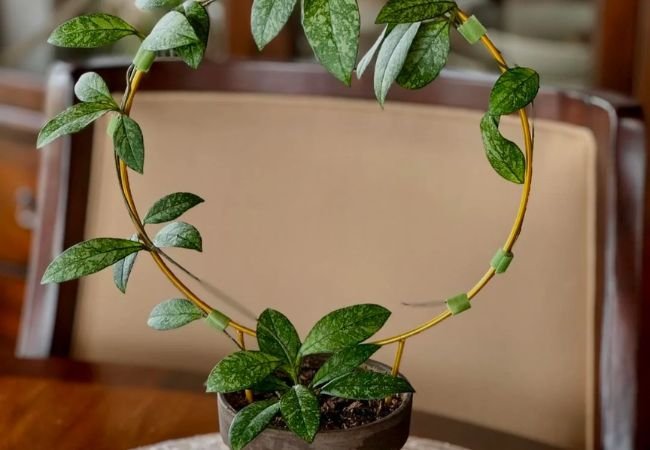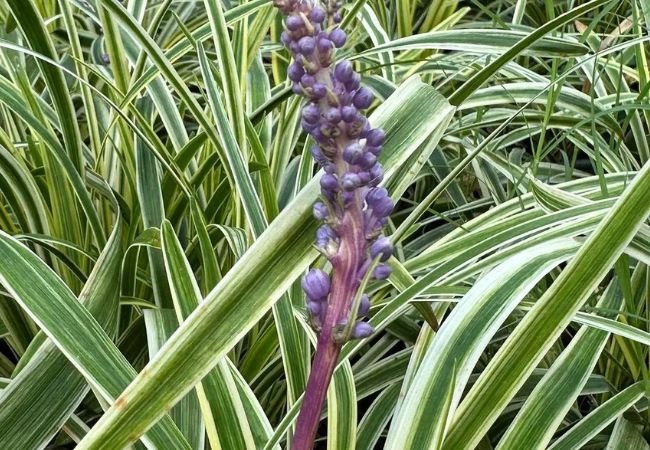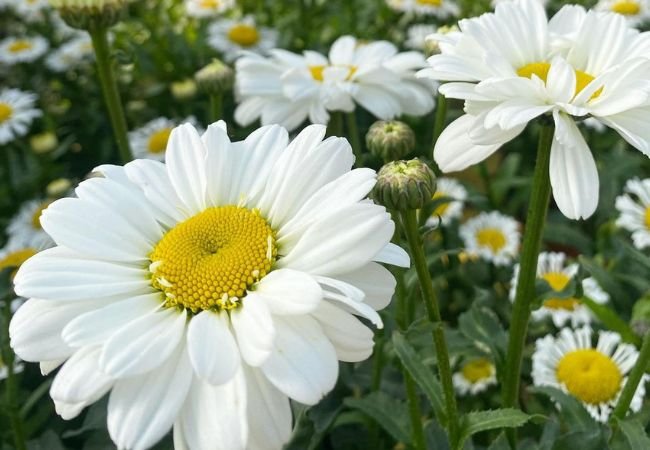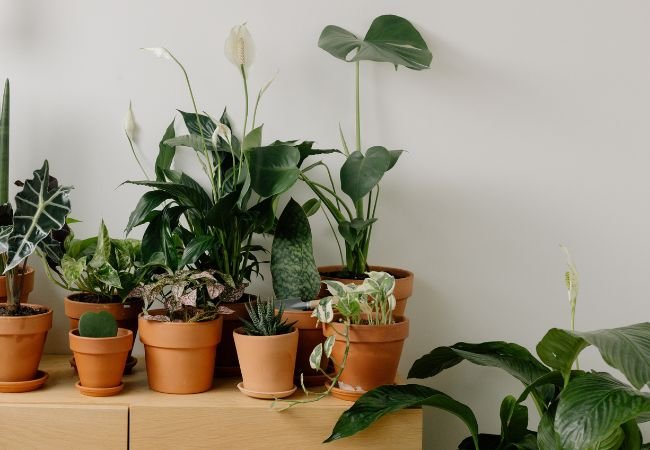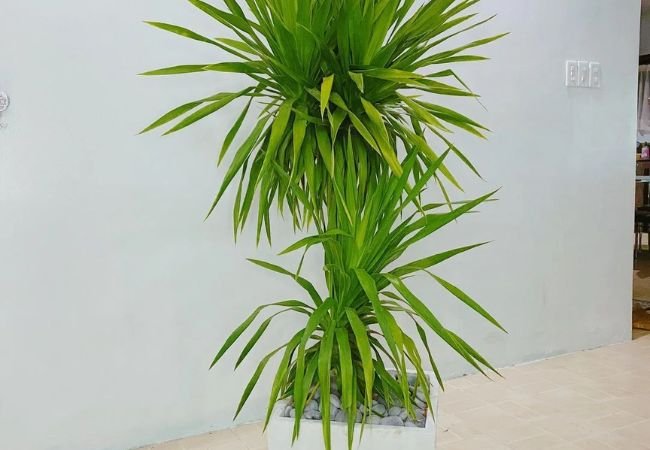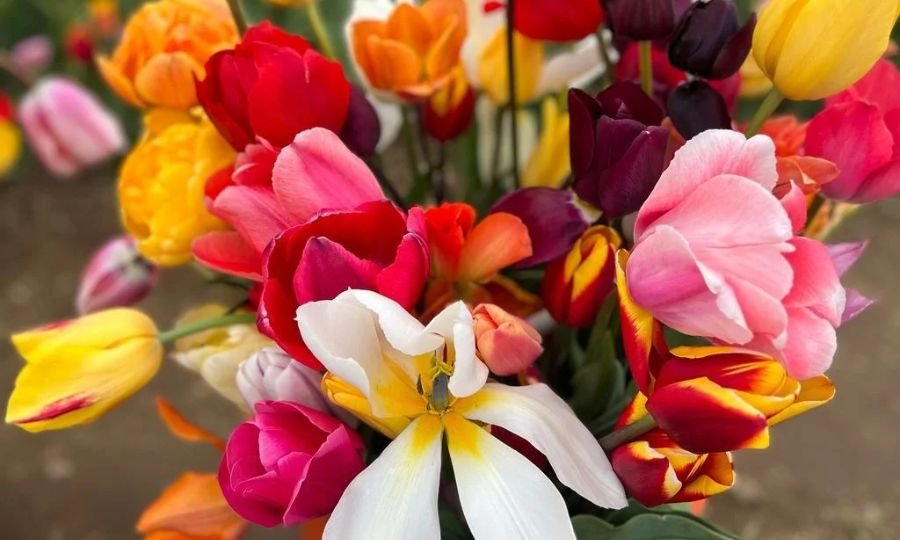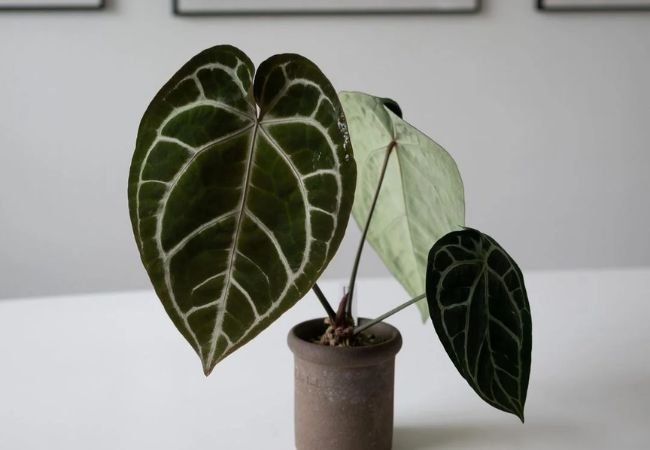Bring the tropics home with 25 stunning Alocasia (elephant ear) varieties! This guide showcases lush types with black, white, pink and patterned leaves to turn any space into a lush urban jungle. Get growing tips for these eye-catching, low-maintenance indoor plants.
Lush, tropical leaves in shades of green, burgundy, and black? Yes, please! Alocasia plants, also known as elephant ear plants or taro, offer a burst of jungle beauty to any indoor space. With varieties sporting stems marked with zigzags and leaves shaped like arrowheads, shields or actual elephant ears, these eye-catching tropicals demand to be admired.
If you dream of an urban jungle but lack the climate for it outdoors, Alocasia is the perfect plant friend to invite inside. From the dramatic black beauties to the painted cloaks of green and white, there’s an Alocasia variety for everyone. Let’s take a closer look at 25 stunners bound to turn your home into a tropical paradise.
1. Alocasia Amazonica
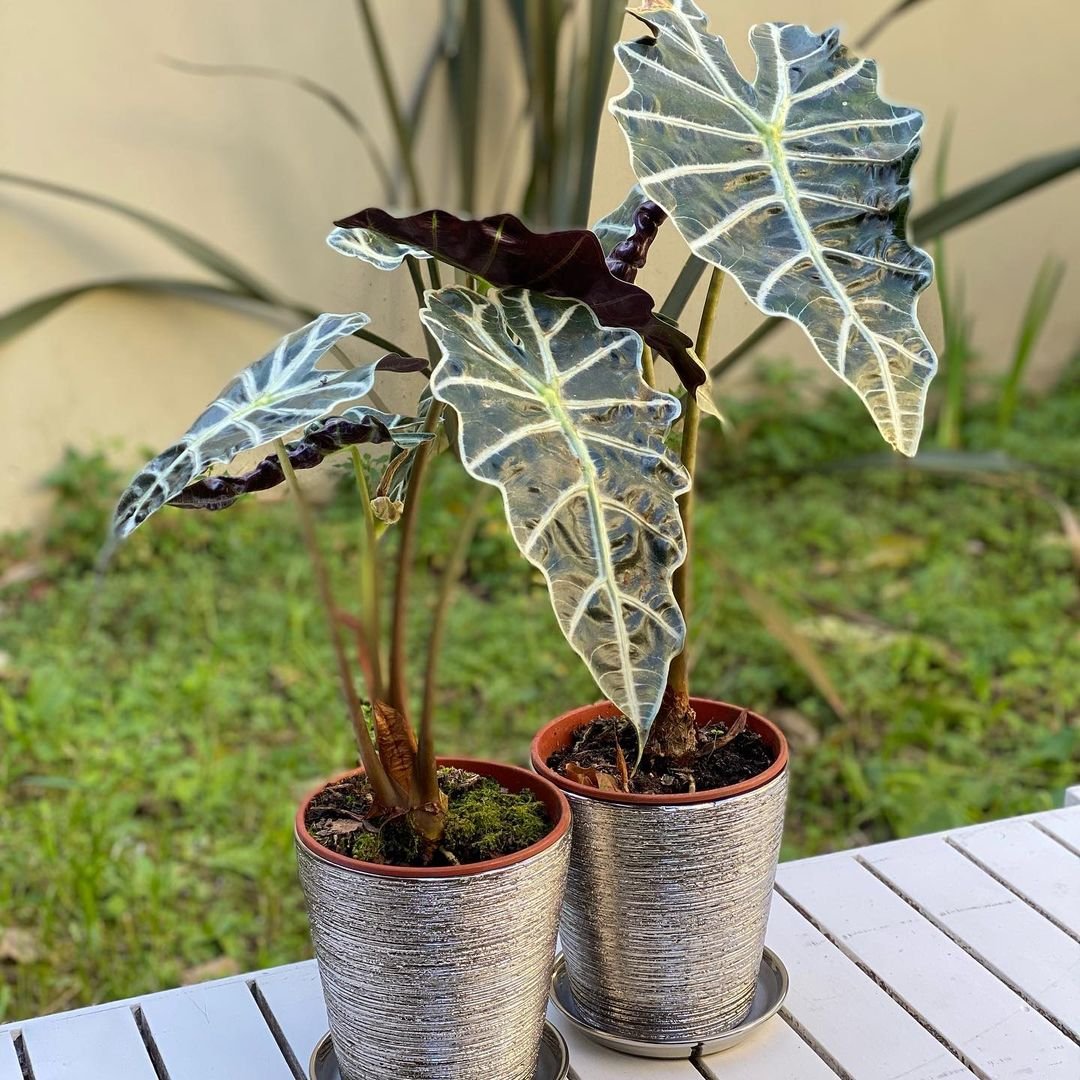
Here’s a brief information chart on Alocasia Amazonica:
| Attribute | Information |
|---|---|
| Scientific Name | Alocasia Amazonica |
| Common Names | Elephant Ear, African Mask Plant |
| Family | Araceae (Arum family) |
| Native to | Hybrid plant; no specific native region |
| Growth Habit | Herbaceous perennial |
| Height | Typically grows 1-2 feet tall indoors |
| Light Requirements | Bright, indirect light |
| Watering Needs | Keep soil consistently moist, but not waterlogged |
| Soil Type | Well-draining, rich in organic matter |
| Temperature Range | Prefers warm temperatures above 60°F (15°C) |
| Humidity | Requires high humidity, around 60-80% |
| Propagation | Division of rhizomes, offsets or by seeds |
| Toxicity | All parts of the plant are toxic if ingested |
| Special Features | Distinctive arrowhead-shaped leaves with prominent veins |
Let’s start big and bold with Alocasia amazonica. True to its name, this giant bears spectacular leaves that can reach up to 4 feet long. The glossy green arrowhead-shaped leaves with prominent veining and wavy edges add a definite wow factor. Just give it a warm, bright spot and it will reward you with jaw-dropping foliage.
2. Alocasia Polly
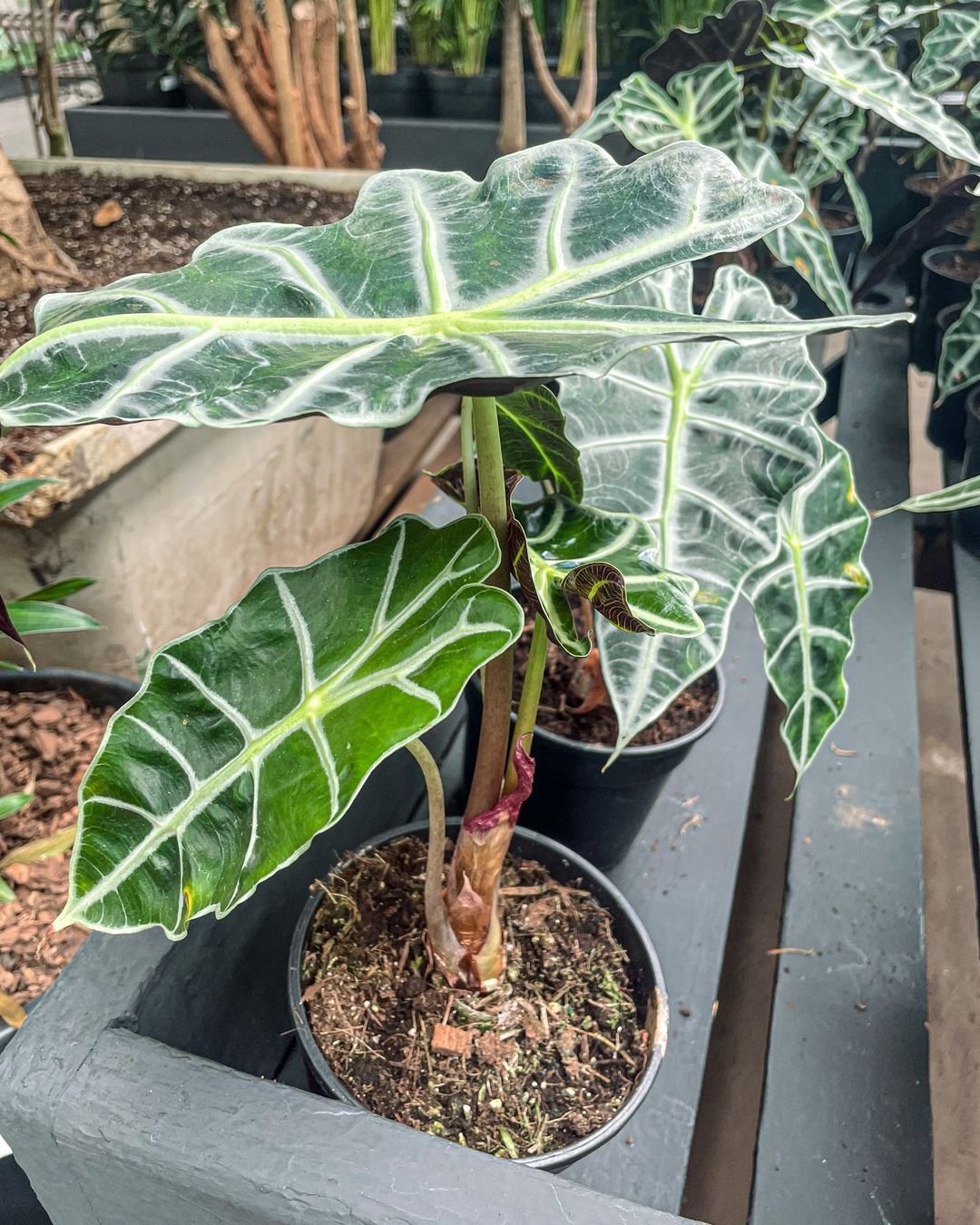
Here’s a brief information chart on Alocasia Polly:
| Attribute | Information |
|---|---|
| Scientific Name | Alocasia Polly |
| Common Names | African Mask Plant, Polly Plant |
| Family | Araceae (Arum family) |
| Native to | Southeast Asia |
| Growth Habit | Herbaceous perennial |
| Height | Typically grows 1-2 feet tall indoors |
| Light Requirements | Bright, indirect light |
| Watering Needs | Keep soil consistently moist, but not waterlogged |
| Soil Type | Well-draining, rich in organic matter |
| Temperature Range | Prefers warm temperatures above 60°F (15°C) |
| Humidity | Requires high humidity, around 60-80% |
| Propagation | Division of rhizomes, offsets or by seeds |
| Toxicity | All parts of the plant are toxic if ingested |
| Special Features | Arrowhead-shaped leaves with dark green color and prominent veins |
A longtime favorite, Polly sports thick, leathery green leaves with heavy texture. The arrowhead leaves have crisp white veins that add stylish contrast. Polly is a little more compact than some Alocasias, making her suited for tabletops or areas with limited floor space but a need for lush greenery.
3. Alocasia Frydek
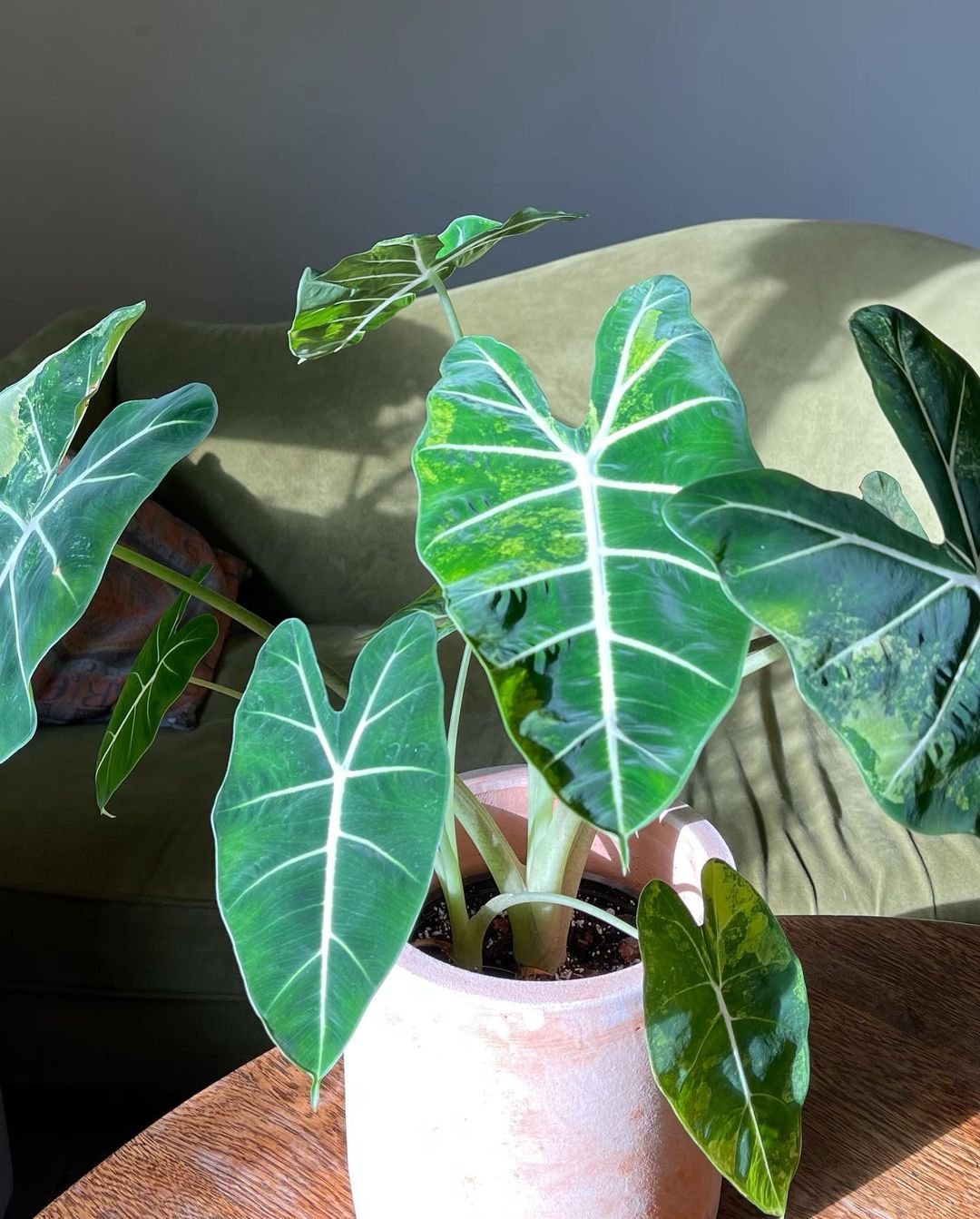
Here’s a brief information chart on Alocasia Frydek:
| Attribute | Information |
|---|---|
| Scientific Name | Alocasia ‘Frydek’ |
| Common Names | Green Velvet Alocasia, Alocasia Micholitziana ‘Frydek’ |
| Family | Araceae (Arum family) |
| Native to | Hybrid plant; no specific native region |
| Growth Habit | Herbaceous perennial |
| Height | Typically grows 1-2 feet tall indoors |
| Light Requirements | Bright, indirect light |
| Watering Needs | Keep soil consistently moist, but not waterlogged |
| Soil Type | Well-draining, rich in organic matter |
| Temperature Range | Prefers warm temperatures above 60°F (15°C) |
| Humidity | Requires high humidity, around 60-80% |
| Propagation | Division of rhizomes, offsets or by seeds |
| Toxicity | All parts of the plant are toxic if ingested |
| Special Features | Distinctive dark green leaves with white veins, resembling a velvet texture |
If you’re craving drama, Alocasia Frydek delivers with its dark green arrowhead leaves edged in glossy black. The blackened margins give this tropical beauty an air of mystery and sophistication. Those dark edges also make the prominent veins pop even more.
4. Black Velvet Alocasia
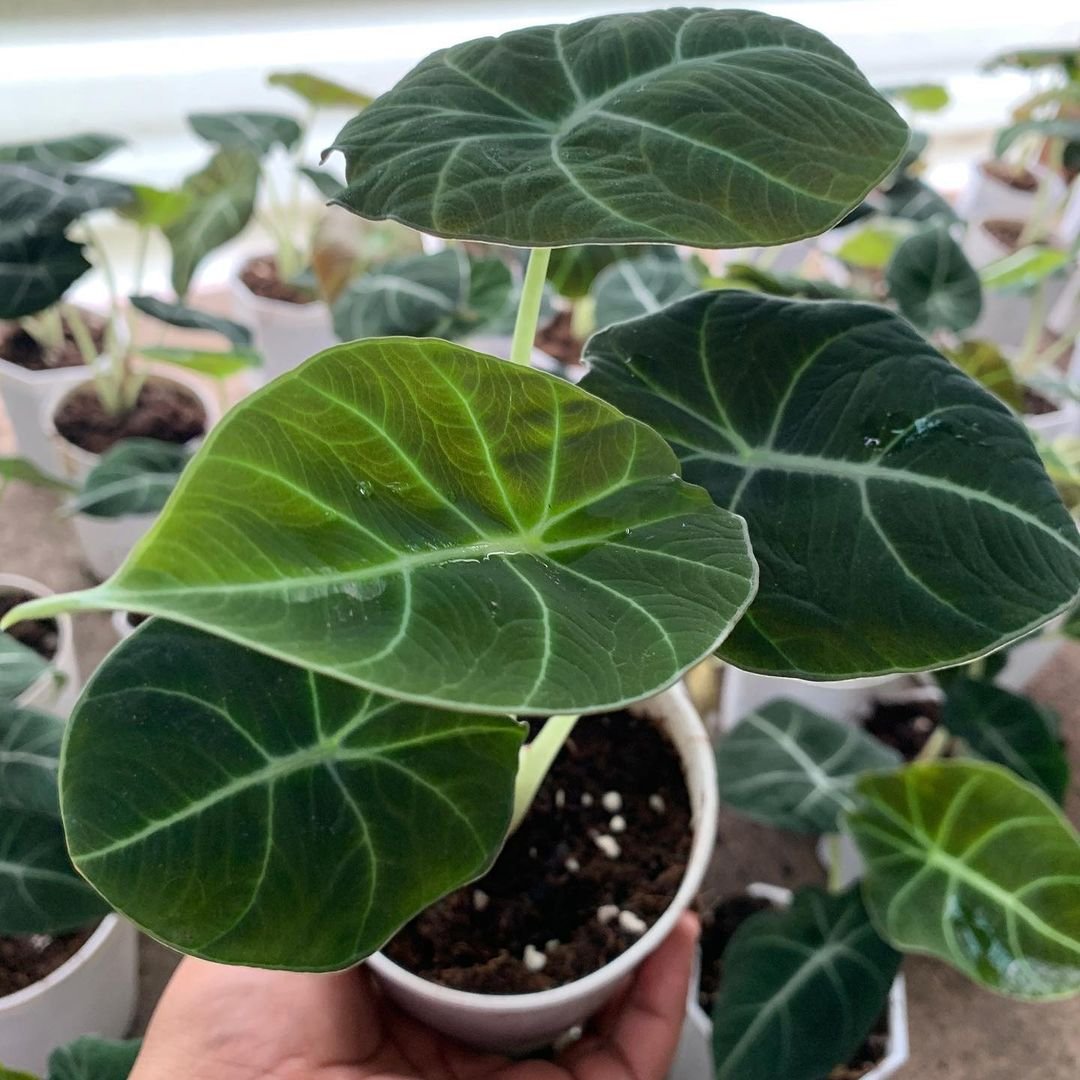
Here’s a brief information chart on Black Velvet Alocasia:
| Attribute | Information |
|---|---|
| Scientific Name | Alocasia reginula |
| Common Names | Black Velvet Alocasia, Jewel Alocasia |
| Family | Araceae (Arum family) |
| Native to | Southeast Asia |
| Growth Habit | Herbaceous perennial |
| Height | Typically grows 1-2 feet tall indoors |
| Light Requirements | Bright, indirect light |
| Watering Needs | Keep soil consistently moist, but not waterlogged |
| Soil Type | Well-draining, rich in organic matter |
| Temperature Range | Prefers warm temperatures above 60°F (15°C) |
| Humidity | Requires high humidity, around 60-80% |
| Propagation | Division of rhizomes, offsets or by seeds |
| Toxicity | All parts of the plant are toxic if ingested |
| Special Features | Dark, almost black leaves with a velvety texture |
For those who love inky tones, the Black Velvet cultivar is pure goth glamour. Its large, arrow-shaped leaves appear almost completely black, with just a dusting of green towards the base. The velvety texture only amplifies the luxe look. This moody maiden definitely makes a statement.
5. Alocasia Ivory Coast
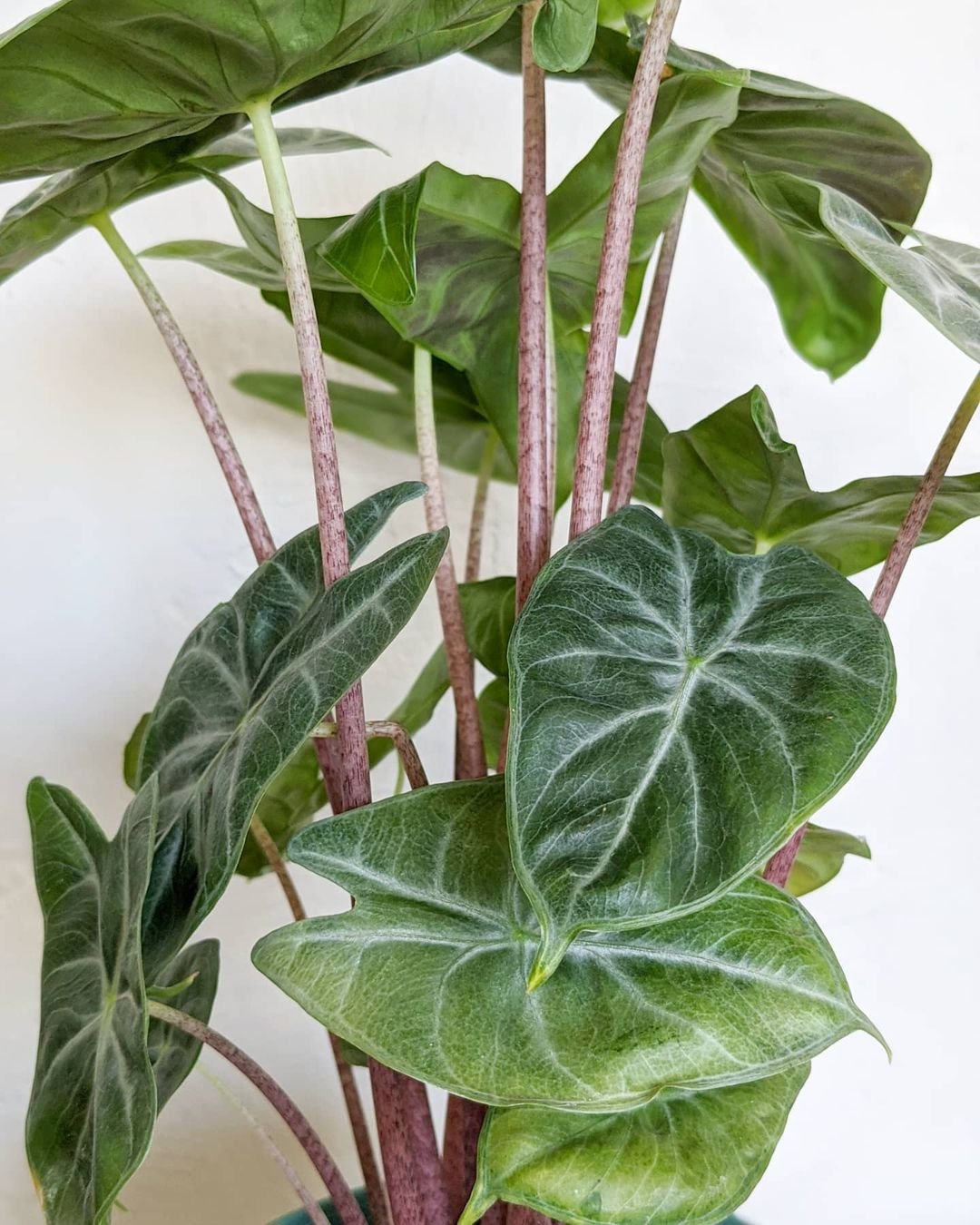
Here’s a brief information chart on Alocasia Ivory Coast:
| Attribute | Information |
|---|---|
| Scientific Name | Alocasia ‘Ivory Coast’ |
| Common Names | Ivory Coast Alocasia |
| Family | Araceae (Arum family) |
| Native to | Hybrid plant; no specific native region |
| Growth Habit | Herbaceous perennial |
| Height | Typically grows 1-2 feet tall indoors |
| Light Requirements | Bright, indirect light |
| Watering Needs | Keep soil consistently moist, but not waterlogged |
| Soil Type | Well-draining, rich in organic matter |
| Temperature Range | Prefers warm temperatures above 60°F (15°C) |
| Humidity | Requires high humidity, around 60-80% |
| Propagation | Division of rhizomes, offsets or by seeds |
| Toxicity | All parts of the plant are toxic if ingested |
| Special Features | Large, heart-shaped leaves with prominent veins and ivory-white variegation |
Bring a taste of the tropics indoors with pure white Alocasia Ivory Coast. The large leaves lack any green pigment at all, emerging a crisp, chalky white. As they mature, just a whisper of green appears along the midrib and veins for subtle contrast. This rare albino variety adds a bright, clean look to any space.
6. Alocasia Zebrina
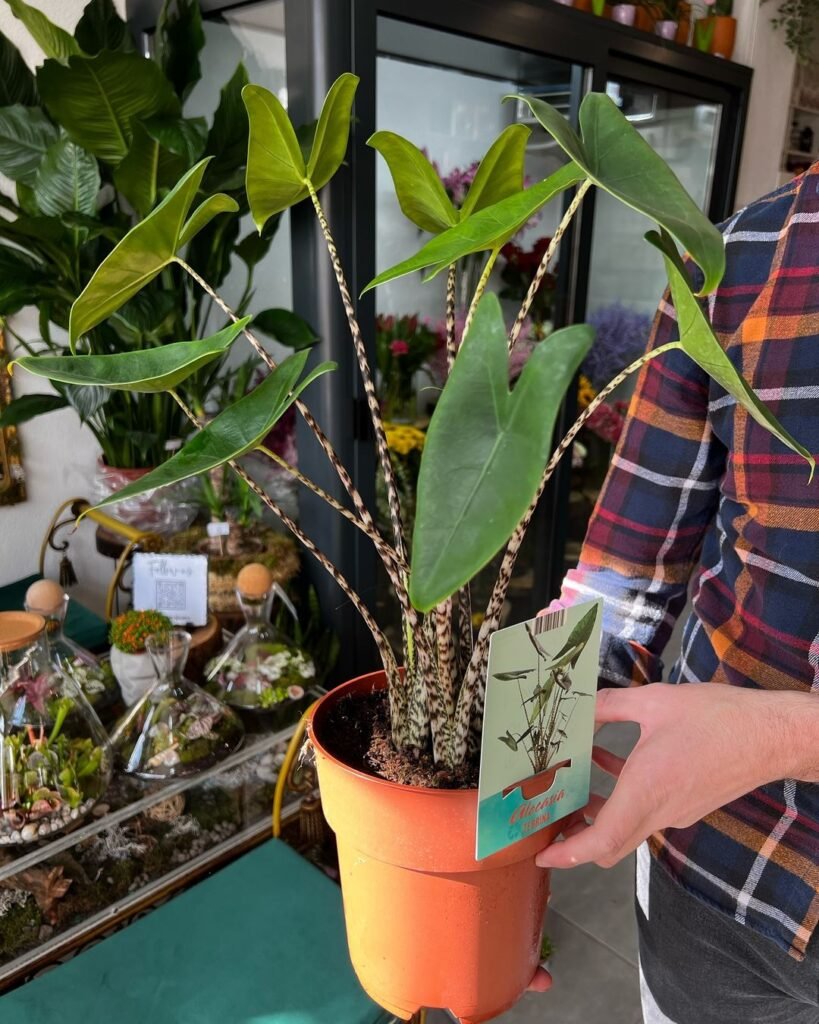
Here’s a brief information chart on Alocasia Zebrina:
| Attribute | Information |
|---|---|
| Scientific Name | Alocasia zebrina |
| Common Names | Elephant Ear, African Mask Plant |
| Family | Araceae (Arum family) |
| Native to | Southeast Asia, specifically the Philippines |
| Growth Habit | Herbaceous perennial |
| Height | Typically grows 2-3 feet tall indoors |
| Light Requirements | Bright, indirect light |
| Watering Needs | Keep soil consistently moist, but not waterlogged |
| Soil Type | Well-draining, rich in organic matter |
| Temperature Range | Prefers warm temperatures above 60°F (15°C) |
| Humidity | Requires high humidity, around 60-80% |
| Propagation | Division of rhizomes, offsets or by seeds |
| Toxicity | All parts of the plant are toxic if ingested |
| Special Features | Distinctive zebra-like striping on stems, large arrowhead-shaped leaves with prominent veins |
This variety earns its stripes with stems marked in a zebra-like pattern of green and inky black. The large, thick green leaves have pronounced veins to match. Alocasia Zebrina makes a bold statement with its high contrast look. Let it be the focus of your indoor jungle.
7. Alocasia Dragon ScaleIf
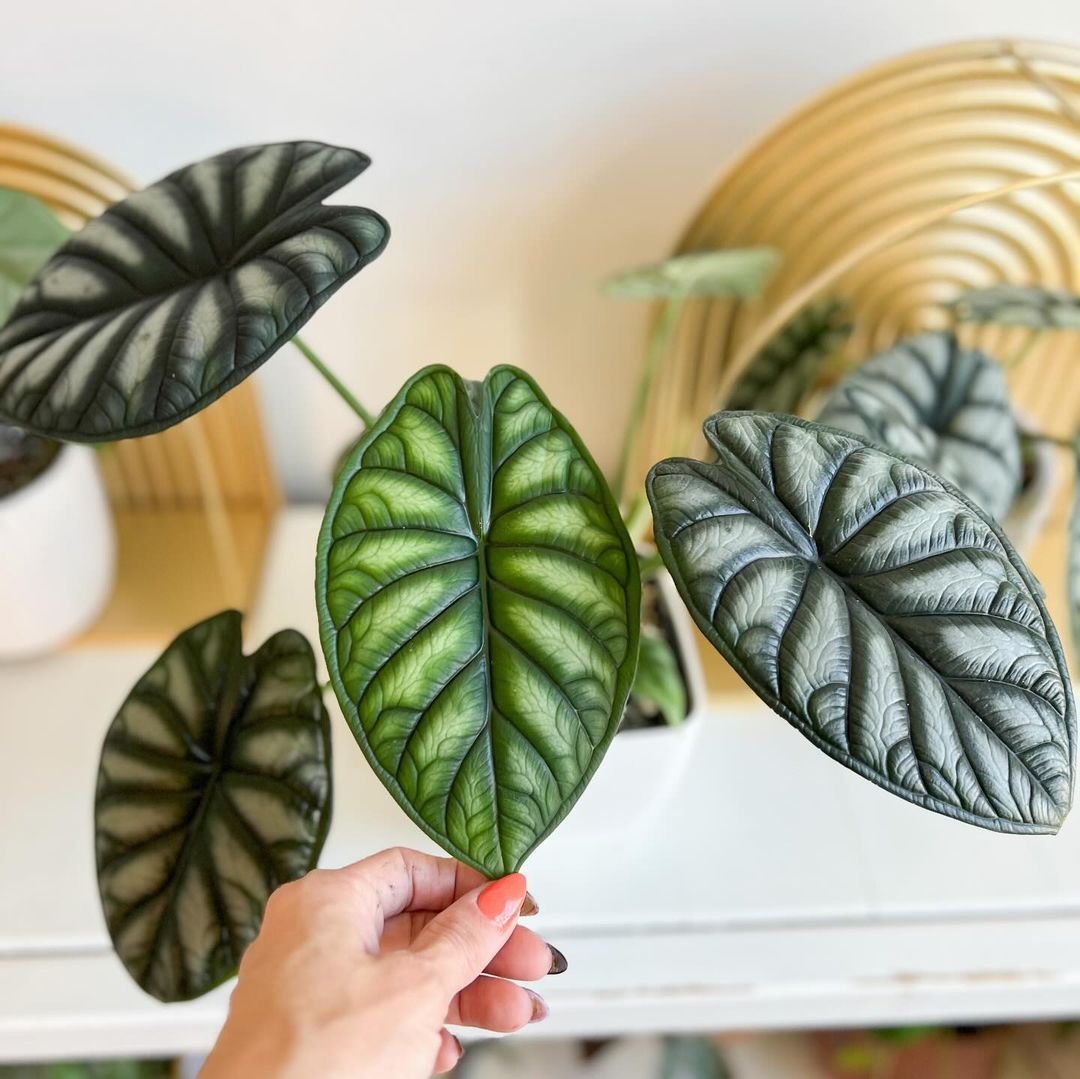
Here’s a brief information chart on Alocasia Dragon Scale:
| Attribute | Information |
|---|---|
| Scientific Name | Alocasia ‘Dragon Scale’ |
| Common Names | Dragon Scale Alocasia |
| Family | Araceae (Arum family) |
| Native to | Hybrid plant; no specific native region |
| Growth Habit | Herbaceous perennial |
| Height | Typically grows 1-2 feet tall indoors |
| Light Requirements | Bright, indirect light |
| Watering Needs | Keep soil consistently moist, but not waterlogged |
| Soil Type | Well-draining, rich in organic matter |
| Temperature Range | Prefers warm temperatures above 60°F (15°C) |
| Humidity | Requires high humidity, around 60-80% |
| Propagation | Division of rhizomes, offsets or by seeds |
| Toxicity | All parts of the plant are toxic if ingested |
| Special Features | Distinctive textured and patterned leaves resembling dragon scales |
you can’t have a pet dragon, the next best thing is Alocasia Dragon Scale. Its wavy green leaves have prominent ridges along the veins, giving them a scaly, textural look straight from mythical lore. The new leaves emerge a bright lime hue, then deepen to dark olive as they age for added dimension.
8. Alocasia Jacklyn
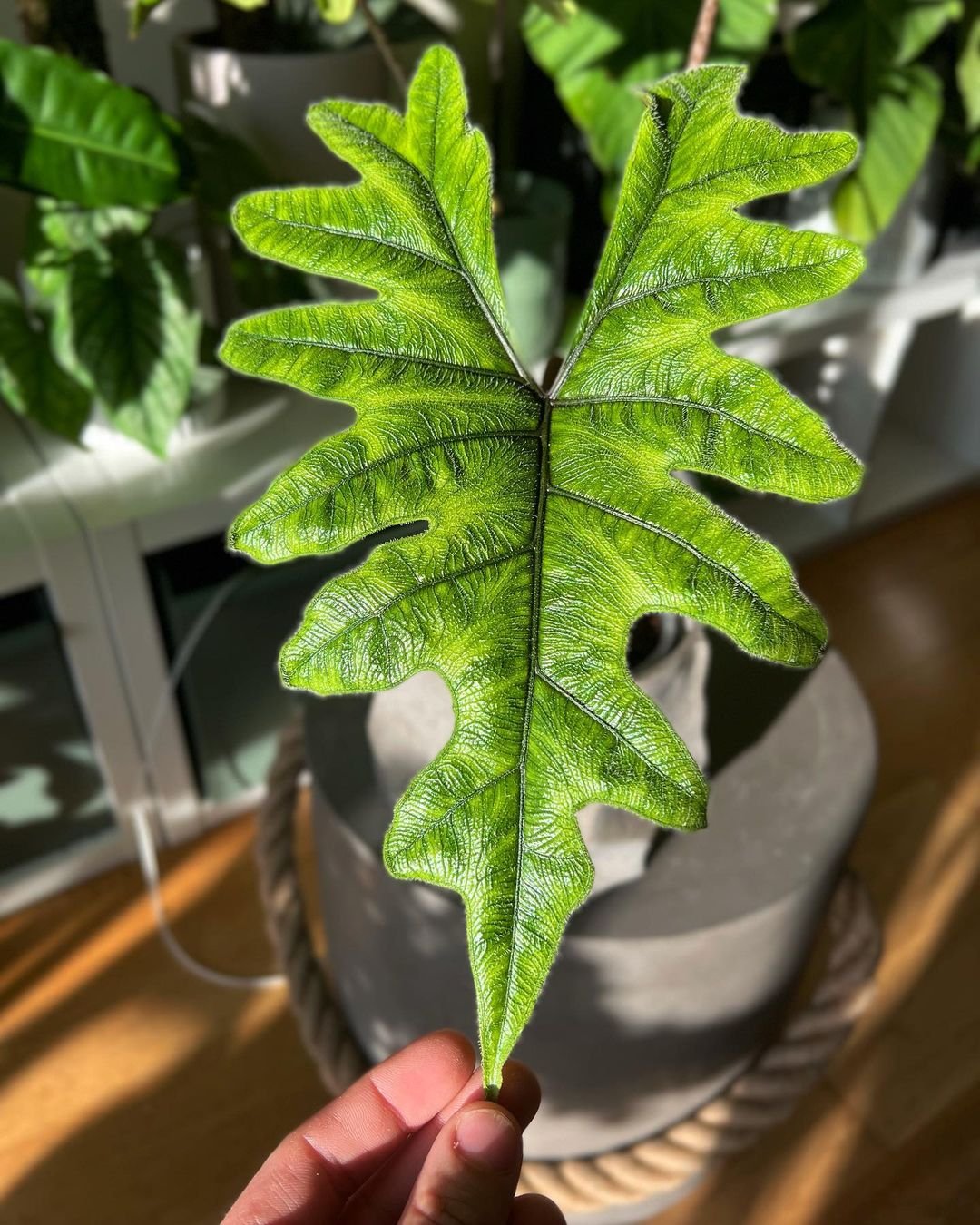
Here’s a brief information chart on Alocasia Jacklyn :
| Attribute | Information |
|---|---|
| Scientific Name | Alocasia Tanduyong |
| Common Names | Alocasia Jacklyn, Tanduayong |
| Family | Araceae (Arum family) |
| Native to | Philippines, particularly in the Bicol Region |
| Growth Habit | Herbaceous perennial |
| Height | Typically grows 2-3 feet tall indoors |
| Light Requirements | Bright, indirect light |
| Watering Needs | Keep soil consistently moist, but not waterlogged |
| Soil Type | Well-draining, rich in organic matter |
| Temperature Range | Prefers warm temperatures above 60°F (15°C) |
| Humidity | Requires high humidity, around 60-80% |
| Propagation | Division of rhizomes, offsets, or by seeds |
| Toxicity | All parts of the plant are toxic if ingested |
| Special Features | Large, arrowhead-shaped leaves with prominent veins |
For fans of the unusual, Alocasia Jacklyn has truly unique foliage. The large, shield-shaped leaves appear to have been dipped in shades of burgundy, green, and near-black, with colors washing over the surface in a watercolor wash. Each leaf exhibits its own one-of-a-kind pattern.
9. African Mask Alocasia
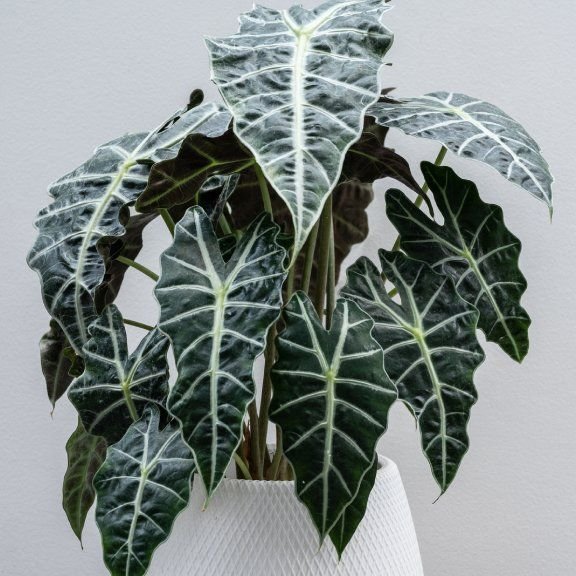
Here’s a brief information chart on African Mask Alocasia :
| Attribute | Information |
|---|---|
| Scientific Name | Alocasia amazonica |
| Common Names | African Mask Alocasia, Elephant Ear |
| Family | Araceae (Arum family) |
| Native to | Hybrid plant; no specific native region |
| Growth Habit | Herbaceous perennial |
| Height | Typically grows 1-2 feet tall indoors |
| Light Requirements | Bright, indirect light |
| Watering Needs | Keep soil consistently moist, but not waterlogged |
| Soil Type | Well-draining, rich in organic matter |
| Temperature Range | Prefers warm temperatures above 60°F (15°C) |
| Humidity | Requires high humidity, around 60-80% |
| Propagation | Division of rhizomes, offsets or by seeds |
| Toxicity | All parts of the plant are toxic if ingested |
| Special Features | Large, glossy, arrowhead-shaped leaves with prominent veins |
I’ll let you debate whether this variety looks more like an African ritual mask or a ghostly pale face peeking through jungle foliage. One thing’s for sure – its ghostly white, rippled leaves placed atop those inky black stems create a haunting look you won’t soon forget.
10. Pink Dragon Alocasia
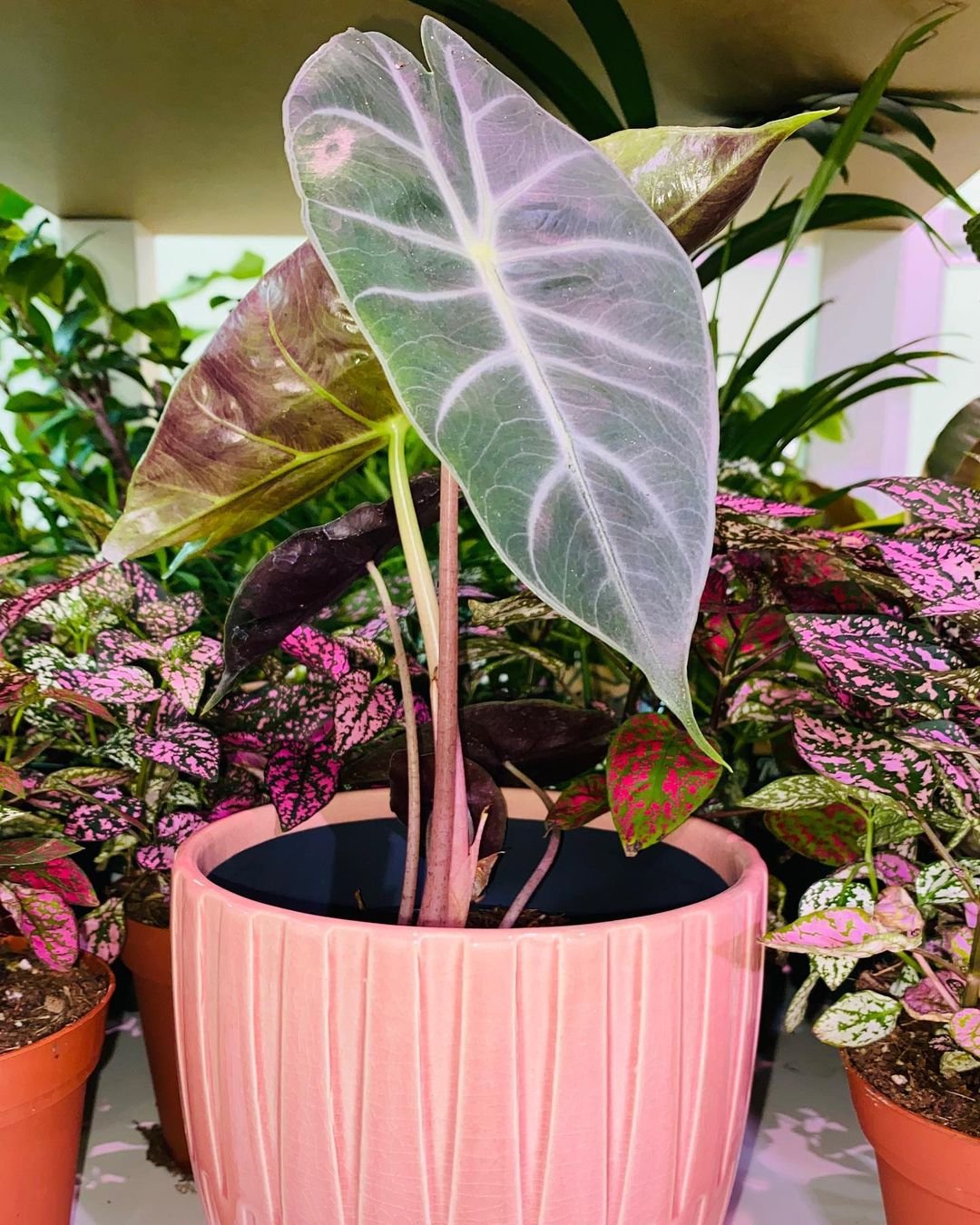
Here’s a brief information chart on Pink Dragon Alocasia :
| Attribute | Information |
|---|---|
| Scientific Name | Alocasia ‘Calidora’ |
| Common Names | Pink Dragon Alocasia |
| Family | Araceae (Arum family) |
| Native to | Hybrid plant; no specific native region |
| Growth Habit | Herbaceous perennial |
| Height | Typically grows 2-3 feet tall indoors |
| Light Requirements | Bright, indirect light |
| Watering Needs | Keep soil consistently moist, but not waterlogged |
| Soil Type | Well-draining, rich in organic matter |
| Temperature Range | Prefers warm temperatures above 60°F (15°C) |
| Humidity | Requires high humidity, around 60-80% |
| Propagation | Division of rhizomes, offsets or by seeds |
| Toxicity | All parts of the plant are toxic if ingested |
| Special Features | Large, arrowhead-shaped leaves with pinkish stems and veins |
While most Alocasias stick to greens and black, Pink Dragon dares to blush. When the new leaves unfurl, they emerge a vibrant pink hue, before transitioning to green with pinkish stems as they mature. Let these funky leaves transport you to an alien world.
11. Alocasia Micholitziana Frydek
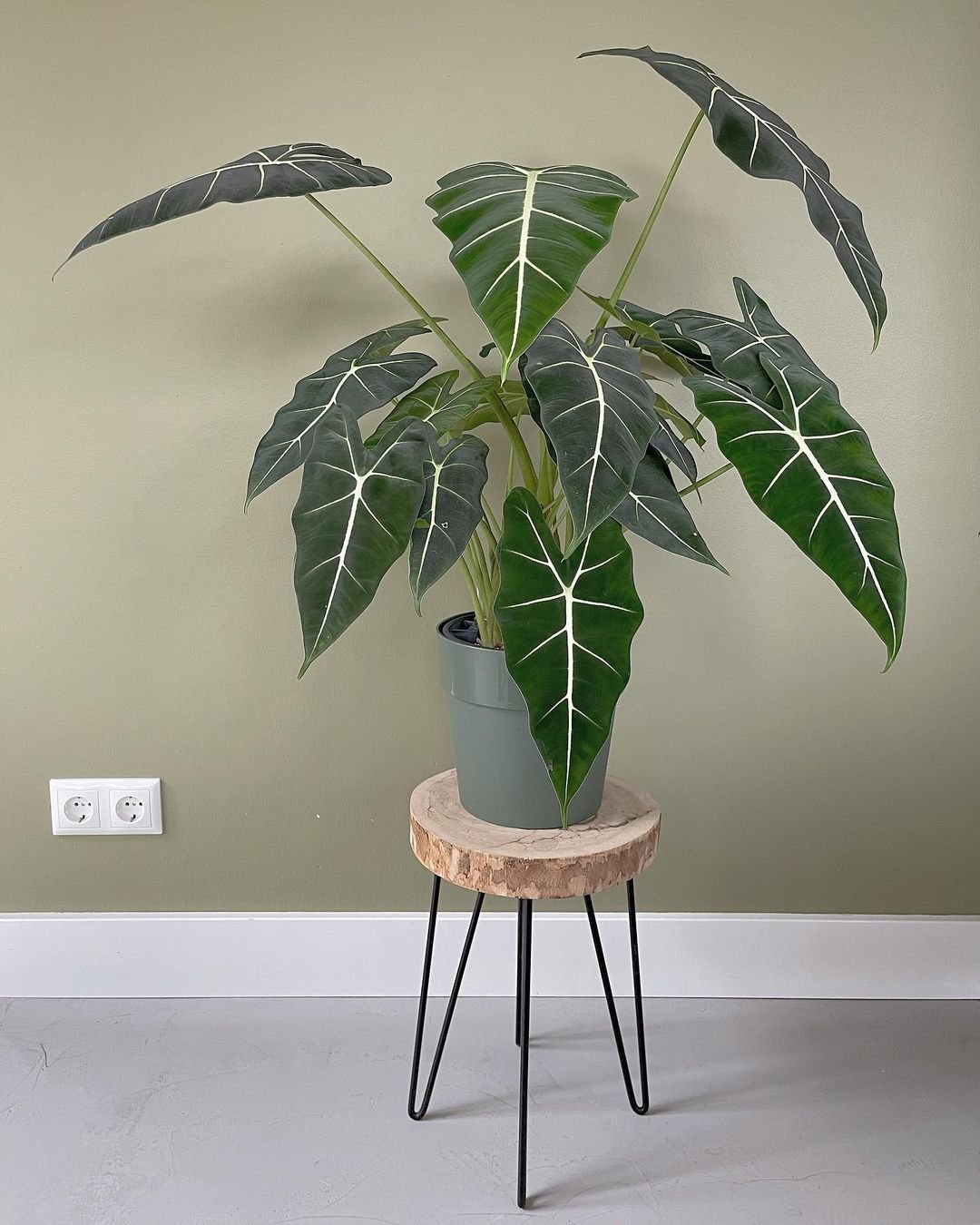
Here’s a brief information chart on Alocasia Micholitziana Frydek :
| Attribute | Information |
|---|---|
| Scientific Name | Alocasia micholitziana ‘Frydek’ |
| Common Names | Frydek Alocasia |
| Family | Araceae (Arum family) |
| Native to | Hybrid plant; no specific native region |
| Growth Habit | Herbaceous perennial |
| Height | Typically grows 1-2 feet tall indoors |
| Light Requirements | Bright, indirect light |
| Watering Needs | Keep soil consistently moist, but not waterlogged |
| Soil Type | Well-draining, rich in organic matter |
| Temperature Range | Prefers warm temperatures above 60°F (15°C) |
| Humidity | Requires high humidity, around 60-80% |
| Propagation | Division of rhizomes, offsets or by seeds |
| Toxicity | All parts of the plant are toxic if ingested |
| Special Features | Unique, velvety, dark green leaves with prominent white veins |
Don’t let the fancy name intimidate you – this Thai species is a real charmer. Deep green leaves with dramatic dark edges and veins give Frydek Micholitziana an elegant yet edgy vibe. The glossy texture adds even more depth to the two-tone foliage display.
12. Alocasia Sanderiana
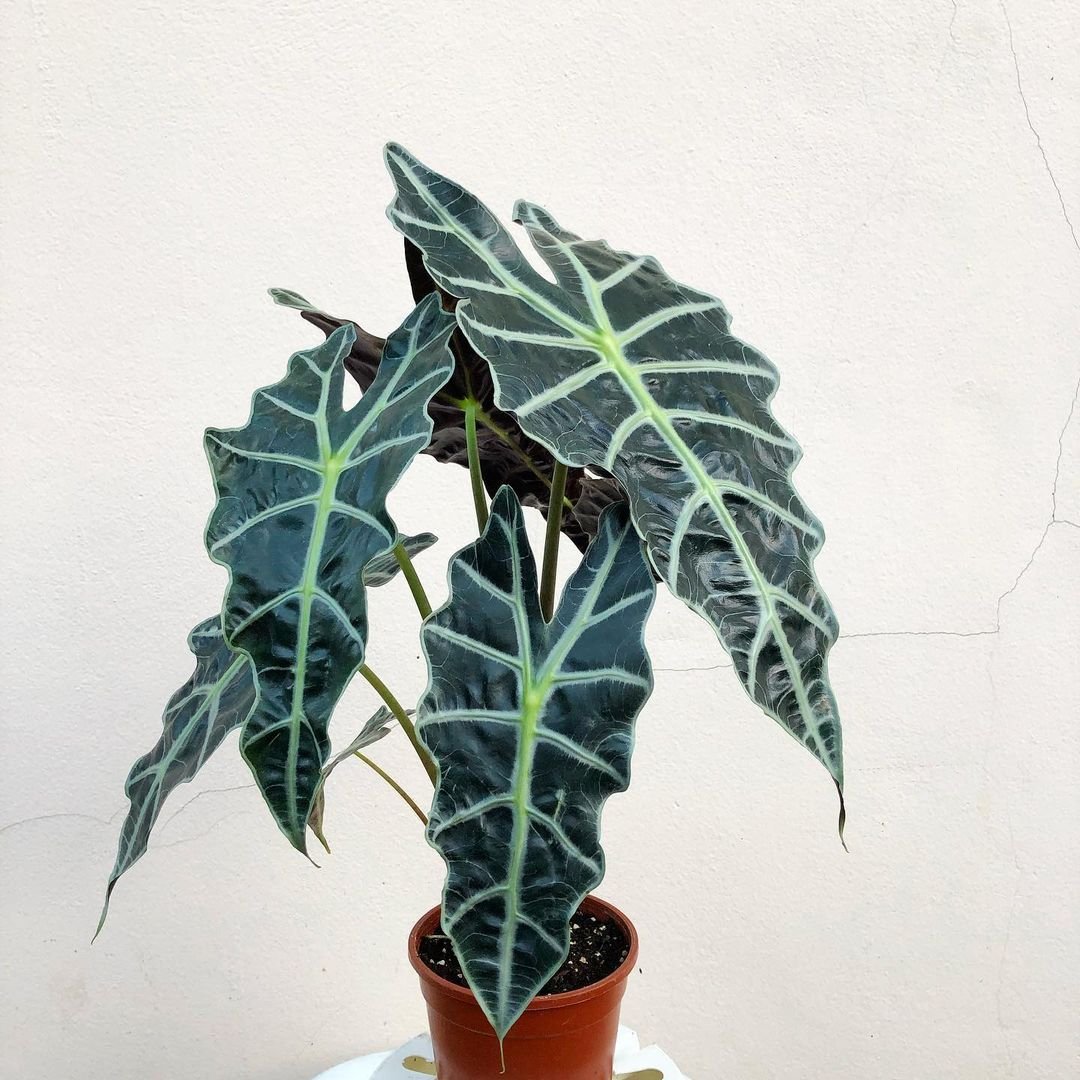
Here’s a brief information chart on Alocasia Sanderiana :
| Attribute | Information |
|---|---|
| Scientific Name | Alocasia sanderiana |
| Common Names | Kris Plant, Kris Plant Alocasia |
| Family | Araceae (Arum family) |
| Native to | Philippines |
| Growth Habit | Herbaceous perennial |
| Height | Typically grows 1-2 feet tall indoors |
| Light Requirements | Bright, indirect light |
| Watering Needs | Keep soil consistently moist, but not waterlogged |
| Soil Type | Well-draining, rich in organic matter |
| Temperature Range | Prefers warm temperatures above 60°F (15°C) |
| Humidity | Requires high humidity, around 60-80% |
| Propagation | Division of rhizomes, offsets or by seeds |
| Toxicity | All parts of the plant are toxic if ingested |
| Special Features | Unique arrow-shaped leaves with wavy edges, resembling a traditional Kris blade |
For the biggest wow factor, look no further than the show-stopping Alocasia sanderiana. This variety has the potential to produce the largest leaves of any Alocasia, with leaf blades reaching over 6 feet long under ideal conditions. The blue-green leaves are heavily veined and arrow-shaped, commanding attention.
13. Alocasia Amazonica Bambino
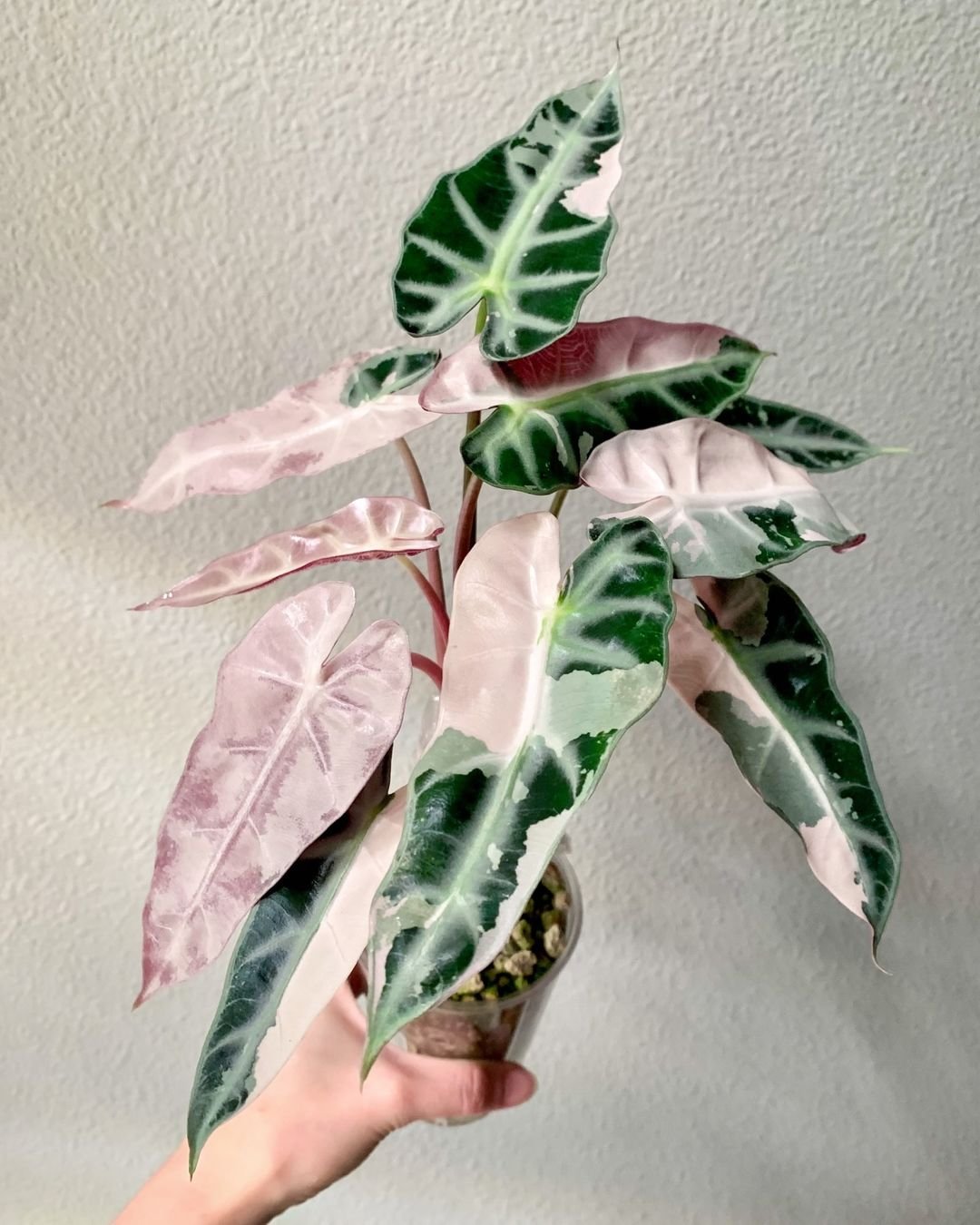
Here’s a brief information chart on Alocasia Amazonica Bambino :
| Attribute | Information |
|---|---|
| Scientific Name | Alocasia Amazonica ‘Bambino’ |
| Common Names | Dwarf Amazonica Alocasia |
| Family | Araceae (Arum family) |
| Native to | Hybrid plant; no specific native region |
| Growth Habit | Herbaceous perennial |
| Height | Typically grows 6-12 inches tall indoors |
| Light Requirements | Bright, indirect light |
| Watering Needs | Keep soil consistently moist, but not waterlogged |
| Soil Type | Well-draining, rich in organic matter |
| Temperature Range | Prefers warm temperatures above 60°F (15°C) |
| Humidity | Requires high humidity, around 60-80% |
| Propagation | Division of rhizomes, offsets or by seeds |
| Toxicity | All parts of the plant are toxic if ingested |
| Special Features | Compact size with the classic Amazonica Alocasia leaf pattern |
If you love the bold beauty of Amazonica but lack the floor space, let me introduce her petit offspring, Bambino. This dwarf cultivar has all the deeply veined, arrowhead-shaped splendor in a neat, compact size. She’s perfect for apartments, desktops, or anywhere a little amazingness is required.
14. Alocasia Sinuata
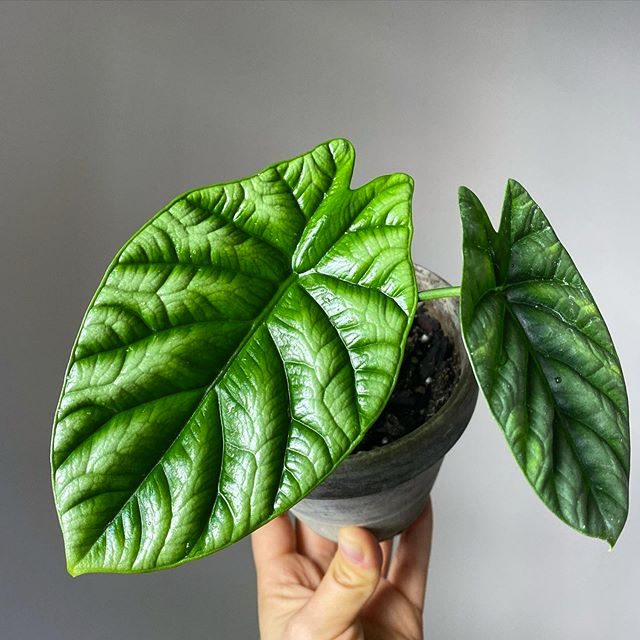
Here’s a brief information chart on Alocasia Sinuata :
| Attribute | Information |
|---|---|
| Scientific Name | Alocasia sinuata |
| Common Names | N/A |
| Family | Araceae (Arum family) |
| Native to | Southeast Asia |
| Growth Habit | Herbaceous perennial |
| Height | Typically grows up to 2-3 feet tall |
| Light Requirements | Bright, indirect light |
| Watering Needs | Keep soil consistently moist, but not waterlogged |
| Soil Type | Well-draining, rich in organic matter |
| Temperature Range | Prefers warm temperatures above 60°F (15°C) |
| Humidity | Requires high humidity, around 60-80% |
| Propagation | Division of rhizomes or by seeds |
| Toxicity | All parts of the plant are toxic if ingested |
| Special Features | Deeply lobed leaves with wavy edges |
For a true taste of the tropics, look no further than the native Alocasia sinuata. Also known as the Wave Taro, it hails from Thailand and Malaysia with gigantic green leaves rippled in concentric waves. Those sculptural leaves will instantly transport you to a Polynesian paradise.
15. Alocasia Maharani
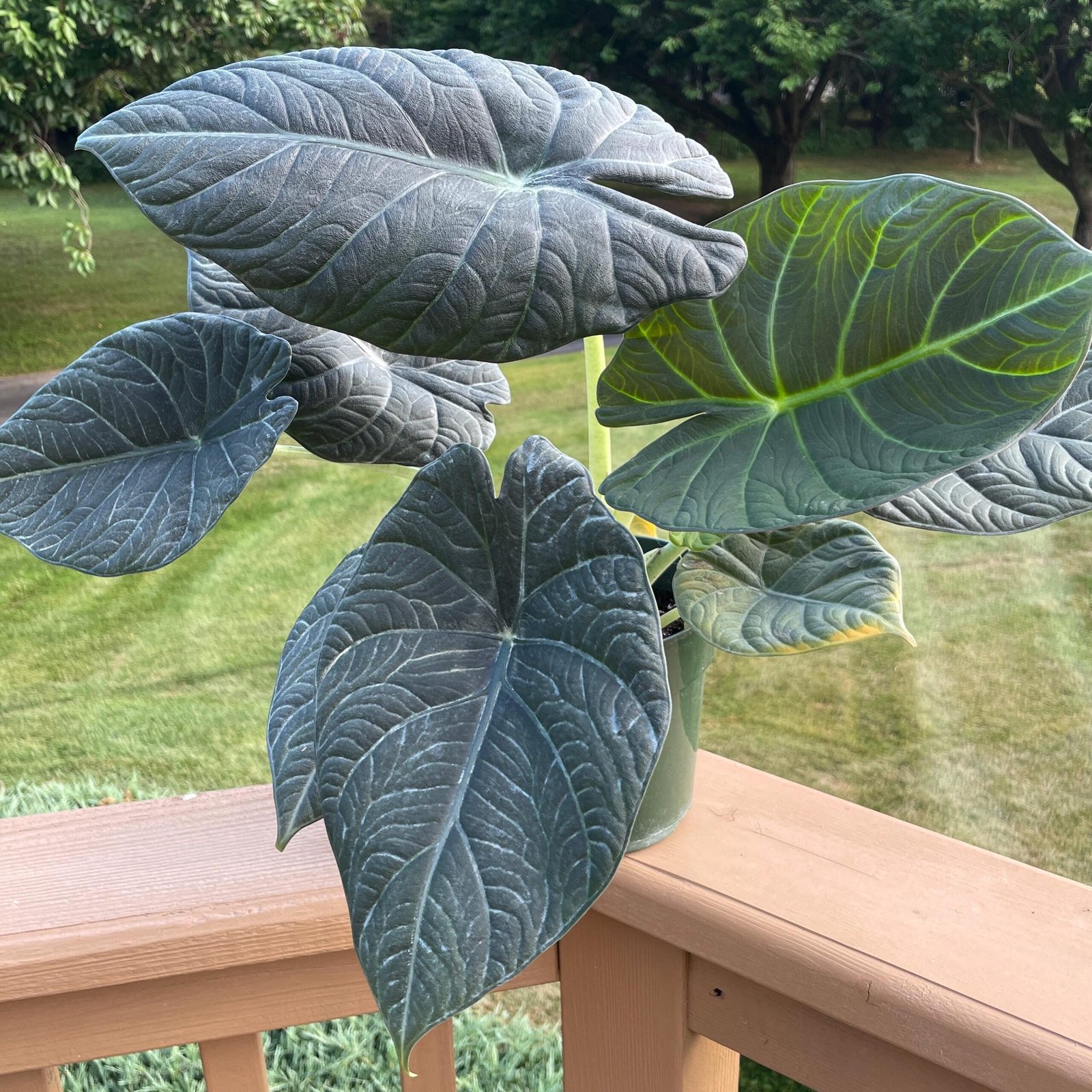
Here’s a brief information chart on Alocasia Maharani :
| Attribute | Information |
|---|---|
| Scientific Name | Alocasia ‘Maharani’ |
| Common Names | Maharani Alocasia |
| Family | Araceae (Arum family) |
| Native to | Hybrid plant; no specific native region |
| Growth Habit | Herbaceous perennial |
| Height | Typically grows 1-2 feet tall indoors |
| Light Requirements | Bright, indirect light |
| Watering Needs | Keep soil consistently moist, but not waterlogged |
| Soil Type | Well-draining, rich in organic matter |
| Temperature Range | Prefers warm temperatures above 60°F (15°C) |
| Humidity | Requires high humidity, around 60-80% |
| Propagation | Division of rhizomes, offsets, or by seeds |
| Toxicity | All parts of the plant are toxic if ingested |
| Special Features | Unique, elongated arrowhead-shaped leaves with intricate veining |
Let’s hear it for the queen – Maharani rules with her gorgeous patterned foliage. This unique variety sports large, shield-shaped leaves covered in a metallic-green circular pattern overlaid on dark green. Those stunning, ornamented leaves will leave your friends asking, “Where did you get that?”
16. Alocasia Plumbea
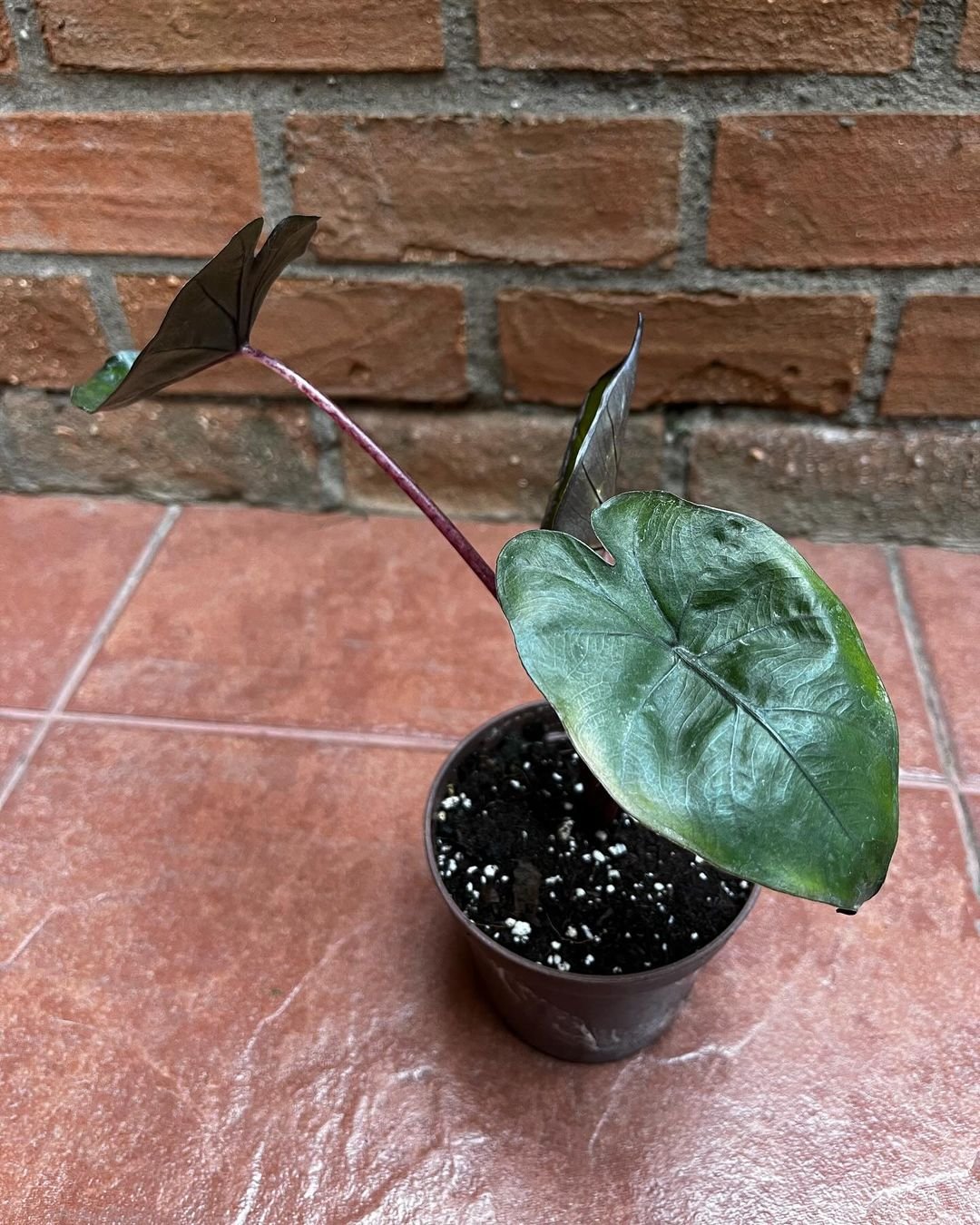
Here’s a brief information chart on Alocasia Plumbea :
| Attribute | Information |
|---|---|
| Scientific Name | Alocasia plumbea |
| Common Names | Blue Alocasia, Metallic Alocasia |
| Family | Araceae (Arum family) |
| Native to | Southeast Asia |
| Growth Habit | Herbaceous perennial |
| Height | Typically grows 1-3 feet tall |
| Light Requirements | Bright, indirect light |
| Watering Needs | Keep soil consistently moist, but not waterlogged |
| Soil Type | Well-draining, rich in organic matter |
| Temperature Range | Prefers warm temperatures above 60°F (15°C) |
| Humidity | Requires high humidity, around 60-80% |
| Propagation | Division of rhizomes or by seeds |
| Toxicity | All parts of the plant are toxic if ingested |
| Special Features | Leaves with a bluish-green hue, metallic sheen |
Inky black leaves? Yes, please! Plumbea mesmerizes with its near-black, arrow-shaped foliage that looks polished in a deep burgundy tone. Those dramatically dark leaves sprout from stems ringed in pale green for extra contrast. This variety is tailor-made for goth gardens.
17. Alocasia Baginda
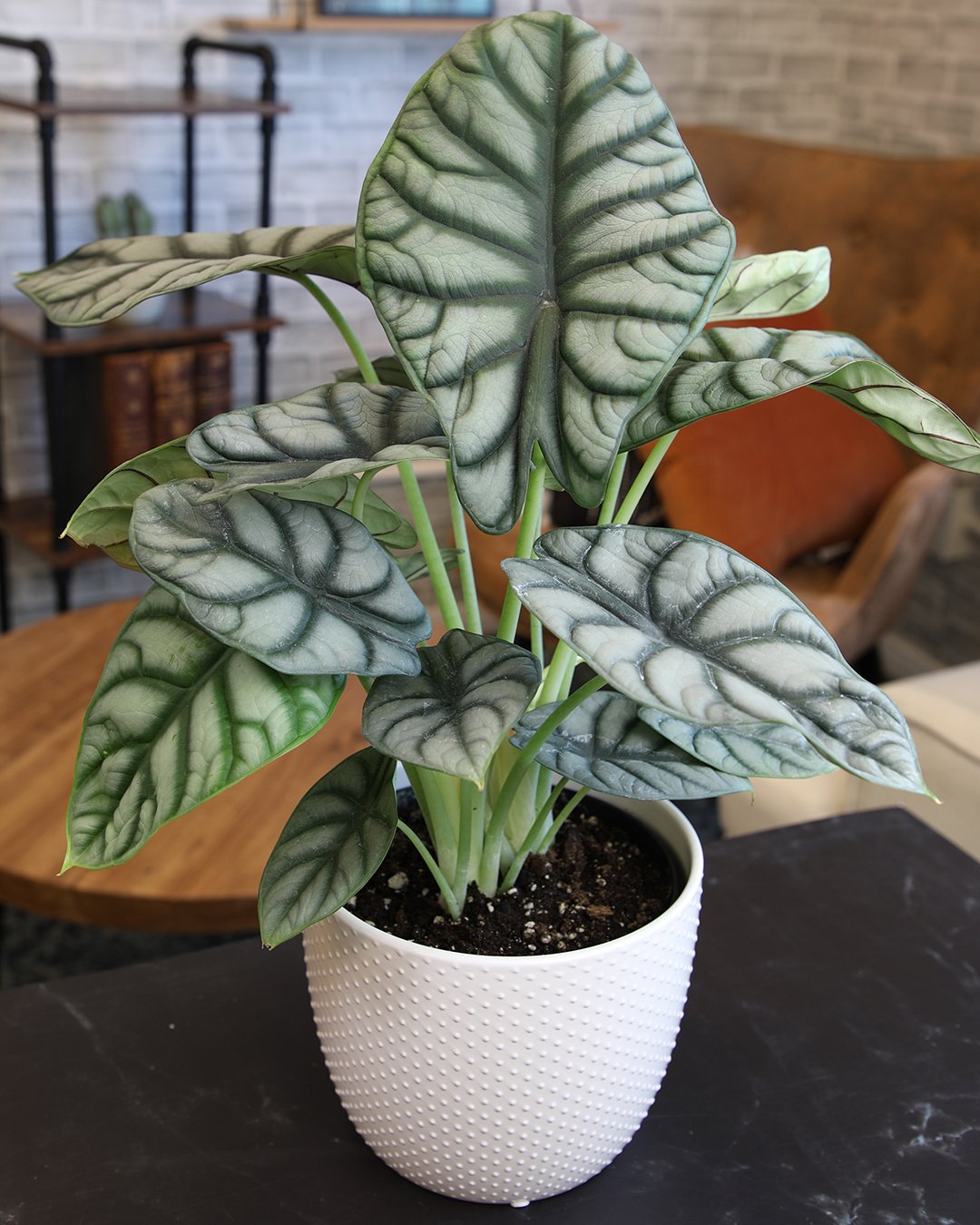
Here’s a brief information chart on Alocasia Baginda :
| Attribute | Information |
|---|---|
| Scientific Name | Alocasia baginda Kurniawan & P.C.Boyce |
| Common Names | Jewel Alocasia, Alocasia baginda |
| Family | Araceae (Arum family) |
| Native to | Borneo, specifically Kalimantan, Indonesia |
| Growth Habit | Herbaceous perennial |
| Height | Typically grows up to 2 feet tall |
| Light Requirements | Bright, indirect light |
| Watering Needs | Keep soil consistently moist, but not waterlogged |
| Soil Type | Well-draining, rich in organic matter |
| Temperature Range | Prefers warm temperatures above 60°F (15°C) |
| Humidity | Requires high humidity, around 60-80% |
| Propagation | Division of rhizomes or by seeds |
| Toxicity | All parts of the plant are toxic if ingested |
| Special Features | Dark green leaves with prominent silver veins |
Not into monochrome leaves? Then the regal Baginda should be your cup of tea. This beauty’s large shield-shaped leaves are a study in shades of green, overlaid with striking white veining. The backsides of the leaves provide extra visual interest in a deep burgundy-purple hue.
18. Alocasia Nobilis
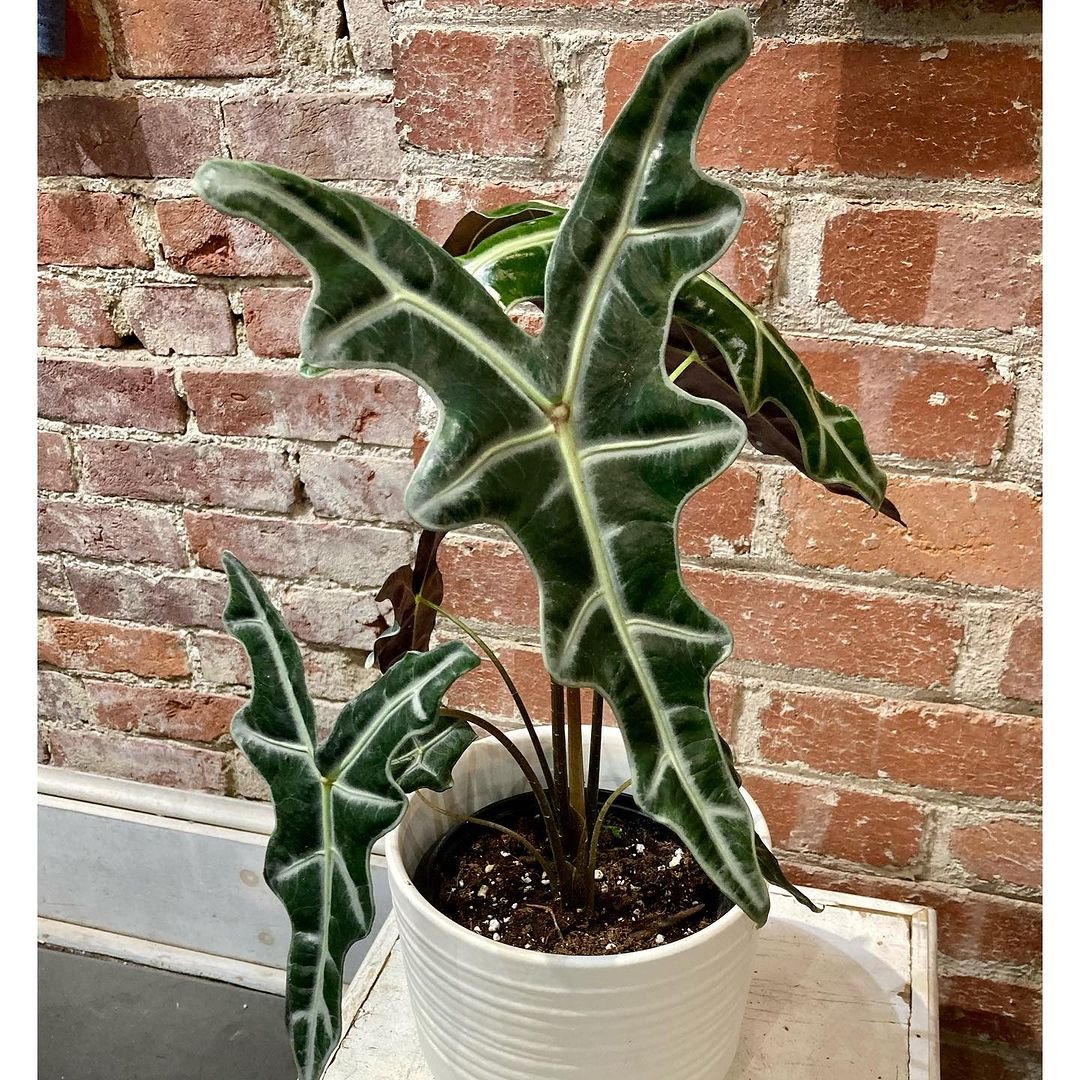
Here’s a brief information chart on Alocasia Nobilis :
| Attribute | Information |
|---|---|
| Scientific Name | Alocasia odora (formerly Alocasia nobilis) |
| Common Names | Giant Elephant Ear, Night-Scented Lily |
| Family | Araceae (Arum family) |
| Native to | Southeast Asia, specifically China and Japan |
| Growth Habit | Herbaceous perennial |
| Height | Typically grows up to 5-8 feet tall |
| Light Requirements | Bright, indirect light |
| Watering Needs | Keep soil consistently moist, but not waterlogged |
| Soil Type | Well-draining, rich in organic matter |
| Temperature Range | Prefers warm temperatures above 60°F (15°C) |
| Humidity | Requires high humidity, around 60-80% |
| Propagation | Division of rhizomes or by seeds |
| Toxicity | All parts of the plant are toxic if ingested |
| Special Features | Large, arrowhead-shaped leaves, pleasant fragrance |
Simple yet stunning, Alocasia nobilis has thick, heavily textured arrow-shaped leaves in a rich, glossy green tone. Their prominent veins add depth and dimension. While not as wild in patterning as some varieties, there’s something so elegant about this stately plant lined with those shield-like leaves.
19. Alocasia Cuprea
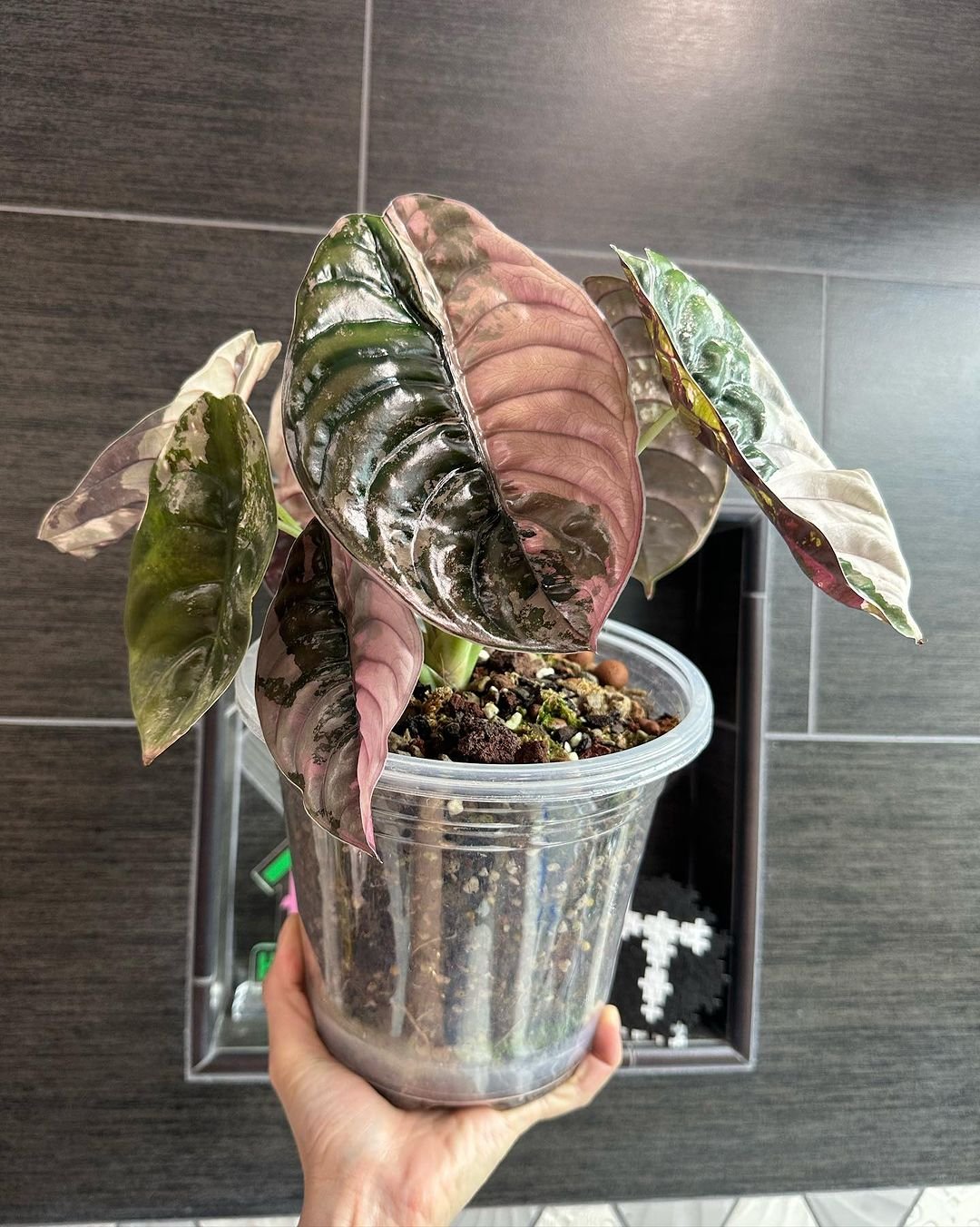
Here’s a brief information chart on Alocasia Cuprea :
| Attribute | Information |
|---|---|
| Scientific Name | Alocasia cuprea |
| Common Names | Jewel Alocasia, Mirror Plant |
| Family | Araceae (Arum family) |
| Native to | Borneo, specifically Kalimantan, Indonesia |
| Growth Habit | Herbaceous perennial |
| Height | Typically grows up to 1-2 feet tall |
| Light Requirements | Bright, indirect light |
| Watering Needs | Keep soil consistently moist, but not waterlogged |
| Soil Type | Well-draining, rich in organic matter |
| Temperature Range | Prefers warm temperatures above 60°F (15°C) |
| Humidity | Requires high humidity, around 60-80% |
| Propagation | Division of rhizomes or by seeds |
| Toxicity | All parts of the plant are toxic if ingested |
| Special Features | Metallic-looking leaves with coppery sheen |
Talk about sultry shades – Alocasia cuprea smolders in deep burgundy, bronze and brownish-green. Its corrugated arrow-shaped leaves have dimensional texture and shine. The darker, brooding tones make a sophisticated statement for indoor gardens.
20. Alocasia Odora
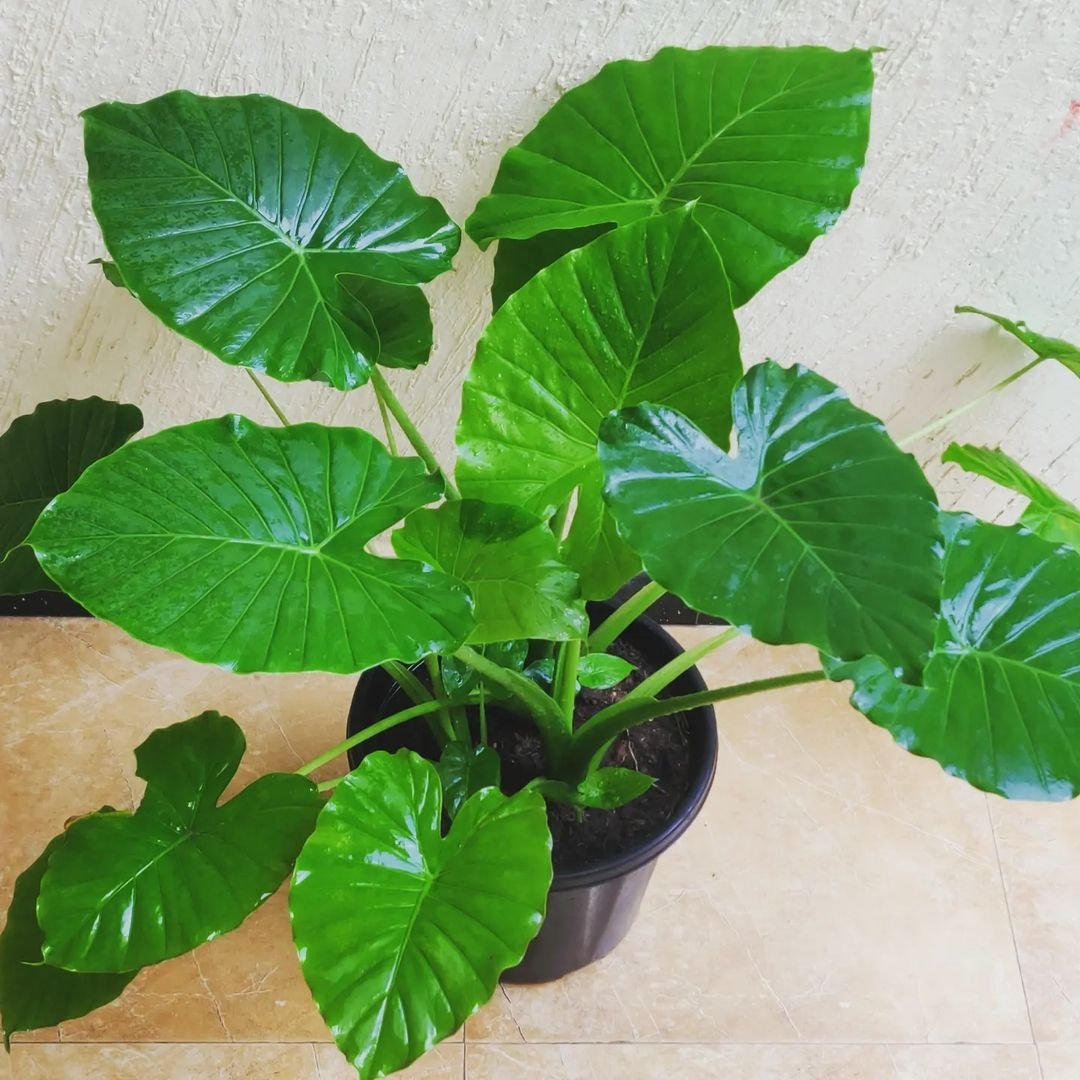
Here’s a brief information chart on Alocasia Odora :
| Attribute | Information |
|---|---|
| Scientific Name | Alocasia odora |
| Common Names | Night-Scented Lily, Giant Taro |
| Family | Araceae (Arum family) |
| Native to | Southeast Asia, particularly China and Japan |
| Growth Habit | Herbaceous perennial |
| Height | Typically grows 4-6 feet tall |
| Light Requirements | Bright, indirect light |
| Watering Needs | Keep soil consistently moist, but not waterlogged |
| Soil Type | Well-draining, rich in organic matter |
| Temperature Range | Prefers warm temperatures above 60°F (15°C) |
| Humidity | Requires high humidity, around 60-80% |
| Propagation | Division of rhizomes or by seeds |
| Toxicity | All parts of the plant are toxic if ingested |
| Special Features | Large, heart-shaped leaves, fragrant flowers |
Don’t let the name fool you – there’s nothing stinky about Odora. This variety turns heads with the silvery patterns decorating its large, veined elephant ear leaves. Whether the markings appear as clouds, marbling or speckles, each leaf exhibits a unique design.
21. Regal Shield Alocasia
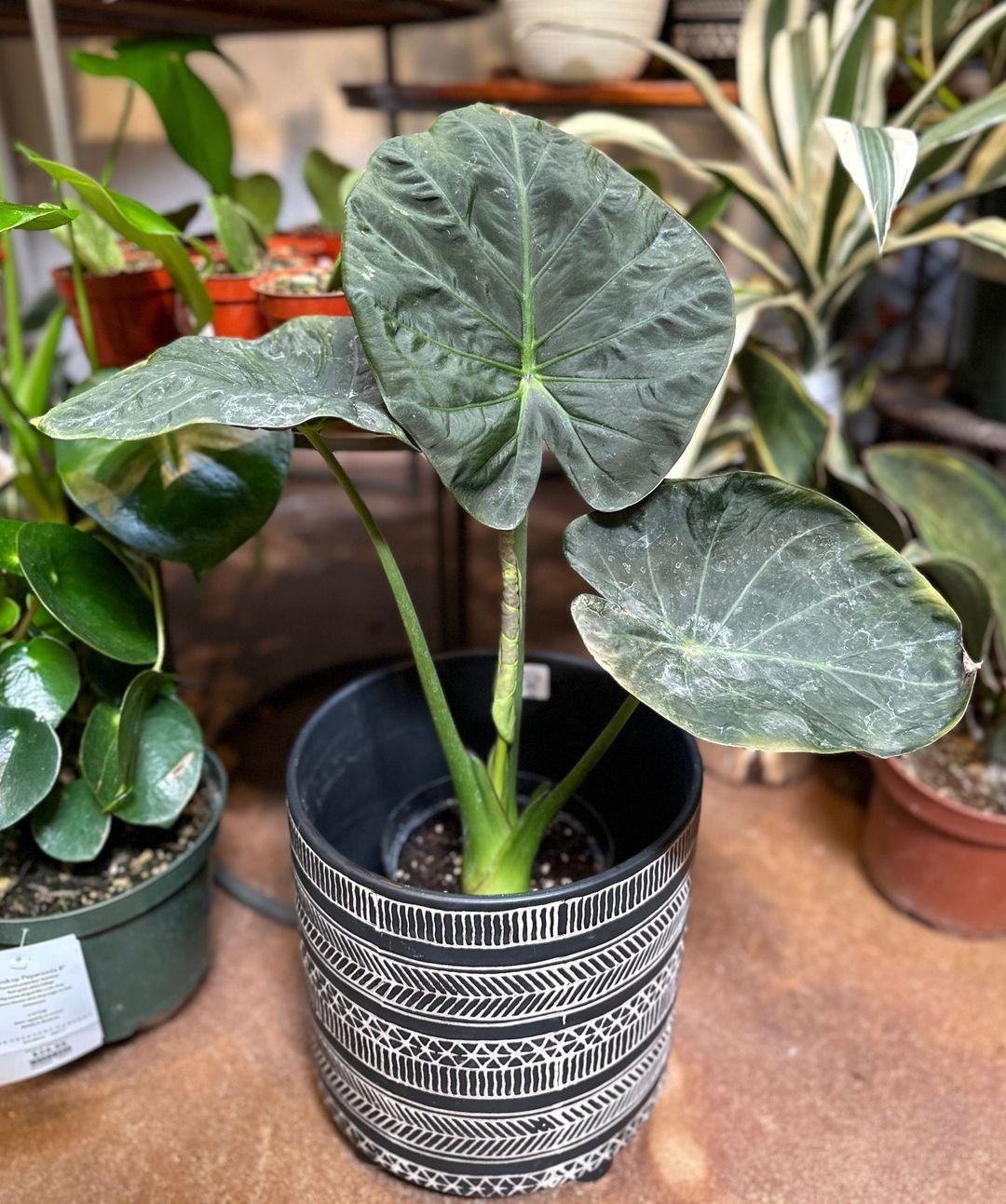
Here’s a brief information chart on Regal Shield Alocasia :
| Attribute | Information |
|---|---|
| Scientific Name | Alocasia ‘Regal Shield’ |
| Common Names | Regal Shield Alocasia |
| Family | Araceae (Arum family) |
| Native to | Hybrid plant; no specific native region |
| Growth Habit | Herbaceous perennial |
| Height | Typically grows 2-3 feet tall indoors |
| Light Requirements | Bright, indirect light |
| Watering Needs | Keep soil consistently moist, but not waterlogged |
| Soil Type | Well-draining, rich in organic matter |
| Temperature Range | Prefers warm temperatures above 60°F (15°C) |
| Humidity | Requires high humidity, around 60-80% |
| Propagation | Division of rhizomes or by seeds |
| Toxicity | All parts of the plant are toxic if ingested |
| Special Features | Large, shield-shaped leaves, impressive size |
If you have fantasies of living in a medieval castle, you’ll love the Bornean Shield. Its mammoth evergreen leaves shaped like – you guessed it – shields impart a real air of regality. Add some armor and horses for a true knight’s watch.
22. Alocasia Macrorrhiza
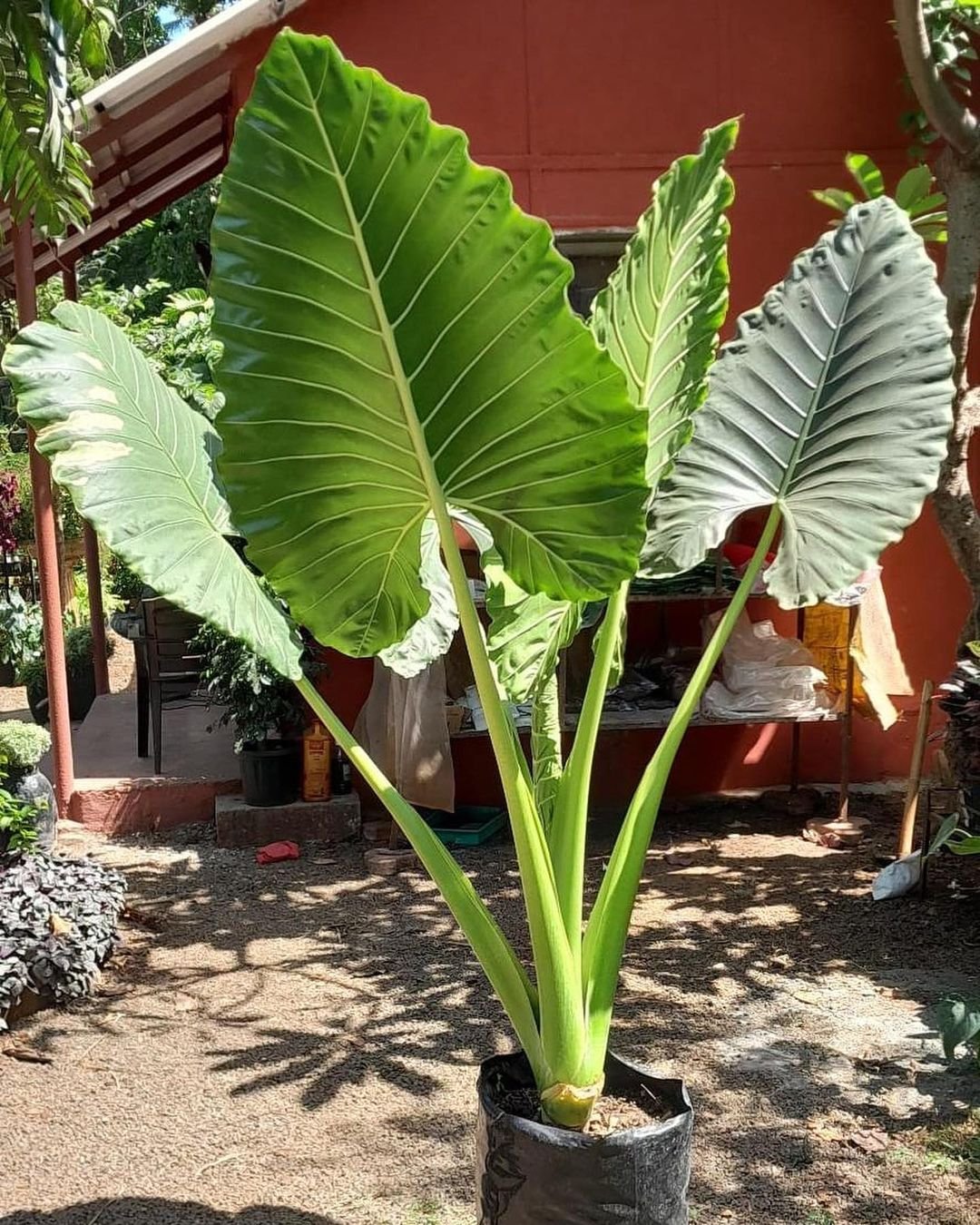
Here’s a brief information chart on Alocasia Macrorrhiza:
| Attribute | Information |
|---|---|
| Scientific Name | Alocasia macrorrhiza |
| Common Names | Giant Taro, Elephant Ear, Giant Alocasia |
| Family | Araceae (Arum family) |
| Native to | Southeast Asia, specifically China and Malaysia |
| Growth Habit | Herbaceous perennial |
| Height | Typically grows 5-10 feet tall |
| Light Requirements | Partial shade to full shade |
| Watering Needs | Keep soil consistently moist |
| Soil Type | Well-draining, rich in organic matter |
| Temperature Range | Thrives in warm temperatures |
| Humidity | Prefers high humidity |
| Propagation | Division of rhizomes or by seeds |
| Toxicity | All parts of the plant are toxic if ingested |
| Special Features | Large, heart-shaped leaves |
This variety stakes its claim with massive leaves up to 5 feet long that emerge in a beautiful pale pink tone. As the leaves mature, they transition to various shades of green with prominent white veins, yet their gargantuan size never fades. Macrorrhiza is truly plant royalty.
23. Alocasia Lowii
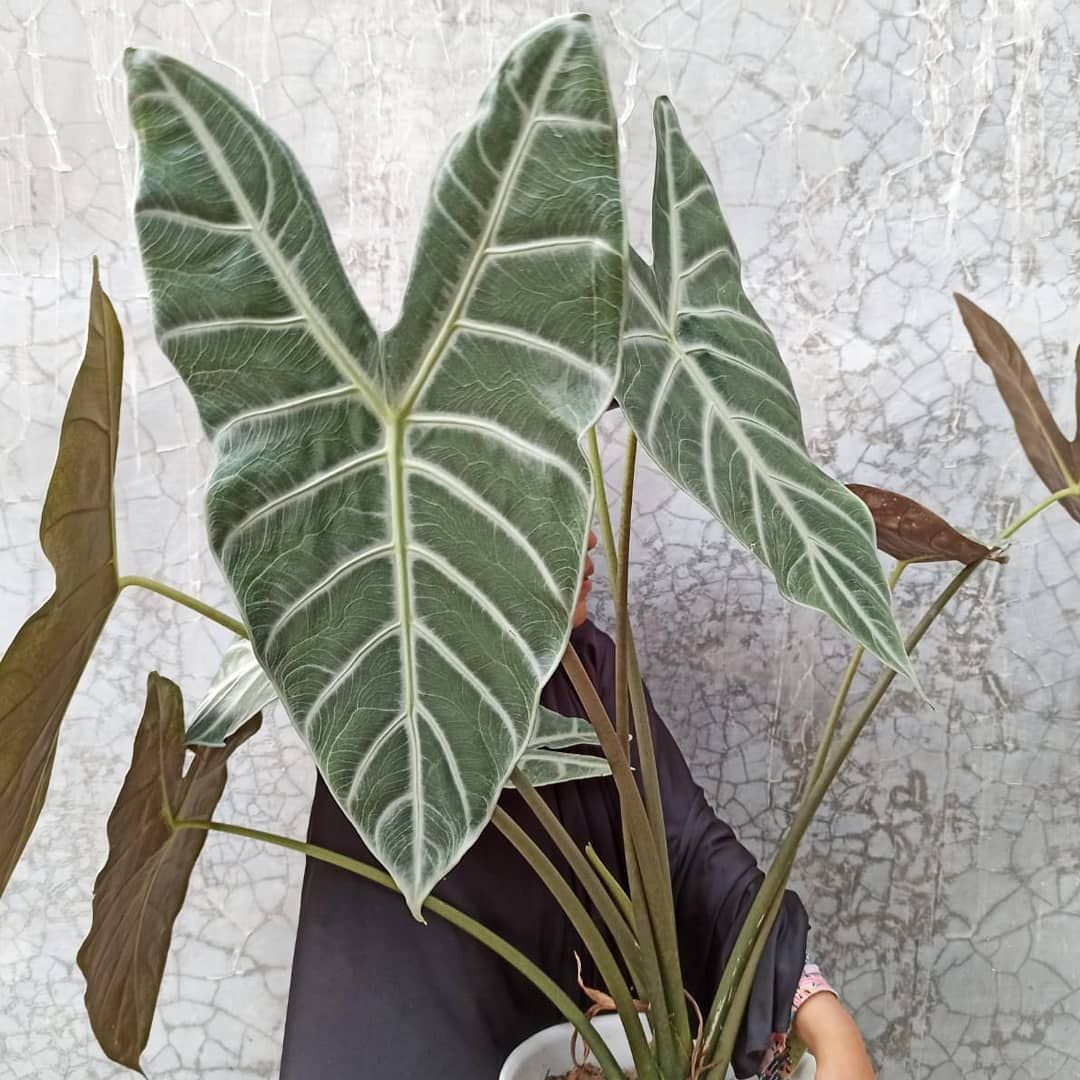
Here’s a brief information chart on Alocasia Lowii :
| Attribute | Information |
|---|---|
| Scientific Name | Alocasia lowii |
| Common Names | Low’s Alocasia |
| Family | Araceae (Arum family) |
| Native to | Borneo, specifically Sabah, Malaysia |
| Growth Habit | Herbaceous perennial |
| Height | Typically grows 1-3 feet tall |
| Light Requirements | Bright, indirect light |
| Watering Needs | Keep soil consistently moist, but not waterlogged |
| Soil Type | Well-draining, rich in organic matter |
| Temperature Range | Prefers warm temperatures above 60°F (15°C) |
| Humidity | Requires high humidity, around 60-80% |
| Propagation | Division of rhizomes or by seeds |
| Toxicity | All parts of the plant are toxic if ingested |
| Special Features | Unique elongated leaves with prominent veins |
Appropriately named for its petite stature, Lowii maxes out at around 2 feet tall. Don’t let the small size fool you though – it packs a punch with its striking dark green leaves etched in contrasting pale green veins. This compact variety is ideal for smaller spaces.
24. Alocasia Wentii
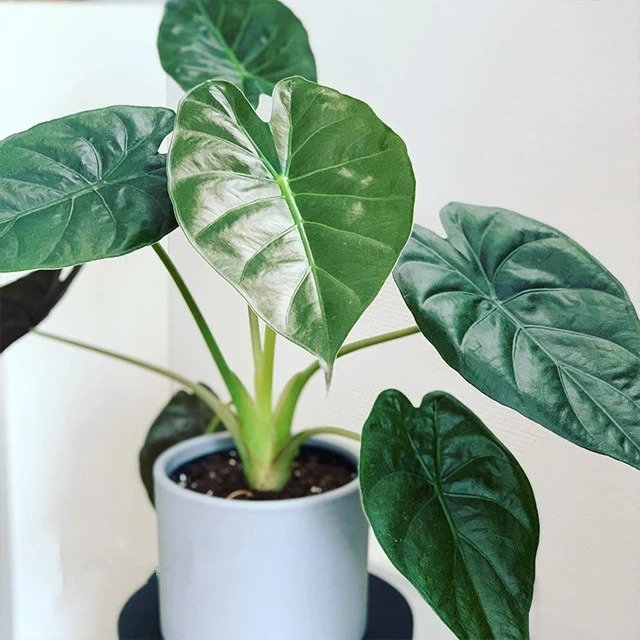
Here’s a brief information chart on Alocasia Wentii :
| Attribute | Information |
|---|---|
| Scientific Name | Alocasia wentii |
| Common Names | Went’s Alocasia |
| Family | Araceae (Arum family) |
| Native to | Southeast Asia, particularly Borneo |
| Growth Habit | Herbaceous perennial |
| Height | Typically grows 2-3 feet tall |
| Light Requirements | Bright, indirect light |
| Watering Needs | Keep soil consistently moist, but not waterlogged |
| Soil Type | Well-draining, rich in organic matter |
| Temperature Range | Prefers warm temperatures above 60°F (15°C) |
| Humidity | Requires high humidity, around 60-80% |
| Propagation | Division of rhizomes or by seeds |
| Toxicity | All parts of the plant are toxic if ingested |
| Special Features | Large, arrowhead-shaped leaves with prominent veins |
Feel like you’re under the sea with Alocasia wentii’s thick, wavy leaves reminiscent of ocean plants. The large, textured olive-green fronds with pronounced veining create an undulating, almost rippling effect. Wentii makes quite the oceanic statement.
25. Alocasia Gageana
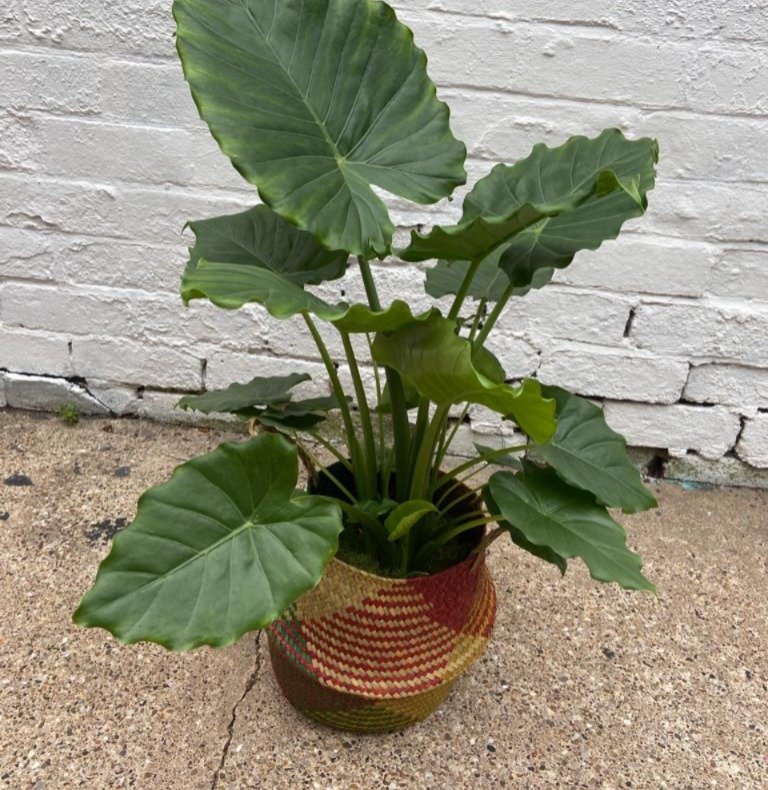
Here’s a brief information chart on Alocasia Gageana :
| Attribute | Information |
|---|---|
| Scientific Name | Alocasia Gageana |
| Common Names | N/A |
| Family | Araceae (Arum family) |
| Native to | Hybrid plant; no specific native region |
| Growth Habit | Herbaceous perennial |
| Height | Typically grows 1-2 feet tall indoors |
| Light Requirements | Bright, indirect light |
| Watering Needs | Keep soil consistently moist, but not waterlogged |
| Soil Type | Well-draining, rich in organic matter |
| Temperature Range | Prefers warm temperatures above 60°F (15°C) |
| Humidity | Requires high humidity, around 60-80% |
| Propagation | Division of rhizomes or by seeds |
| Toxicity | All parts of the plant are toxic if ingested |
| Special Features | Dark, velvety leaves with silver-white veins |
We’ll close out our tour of tropicals with the showstopping Gageana. This variety mesmerizes with large, upright leaves painted in shades of olive, emerald and near-black, with splashes of silver adding an iridescent sheen. Each leaf exhibits unique marbling for a one-of-a-kind masterpiece.
No matter which Alocasia variety calls to you, get ready to turn your space into a lush, jungle-inspired retreat. With their stunning, exotic foliage, these tropical beauties allow you to staycation in paradise all year long. Let the leaf-peeping begin!


